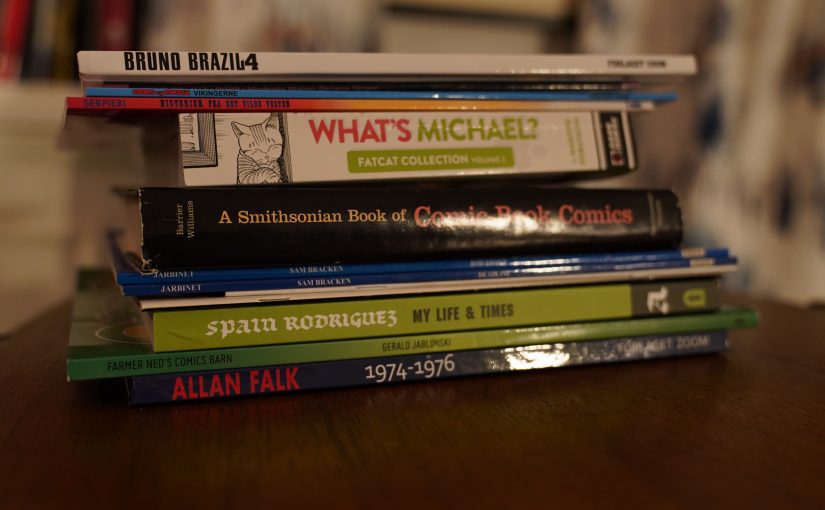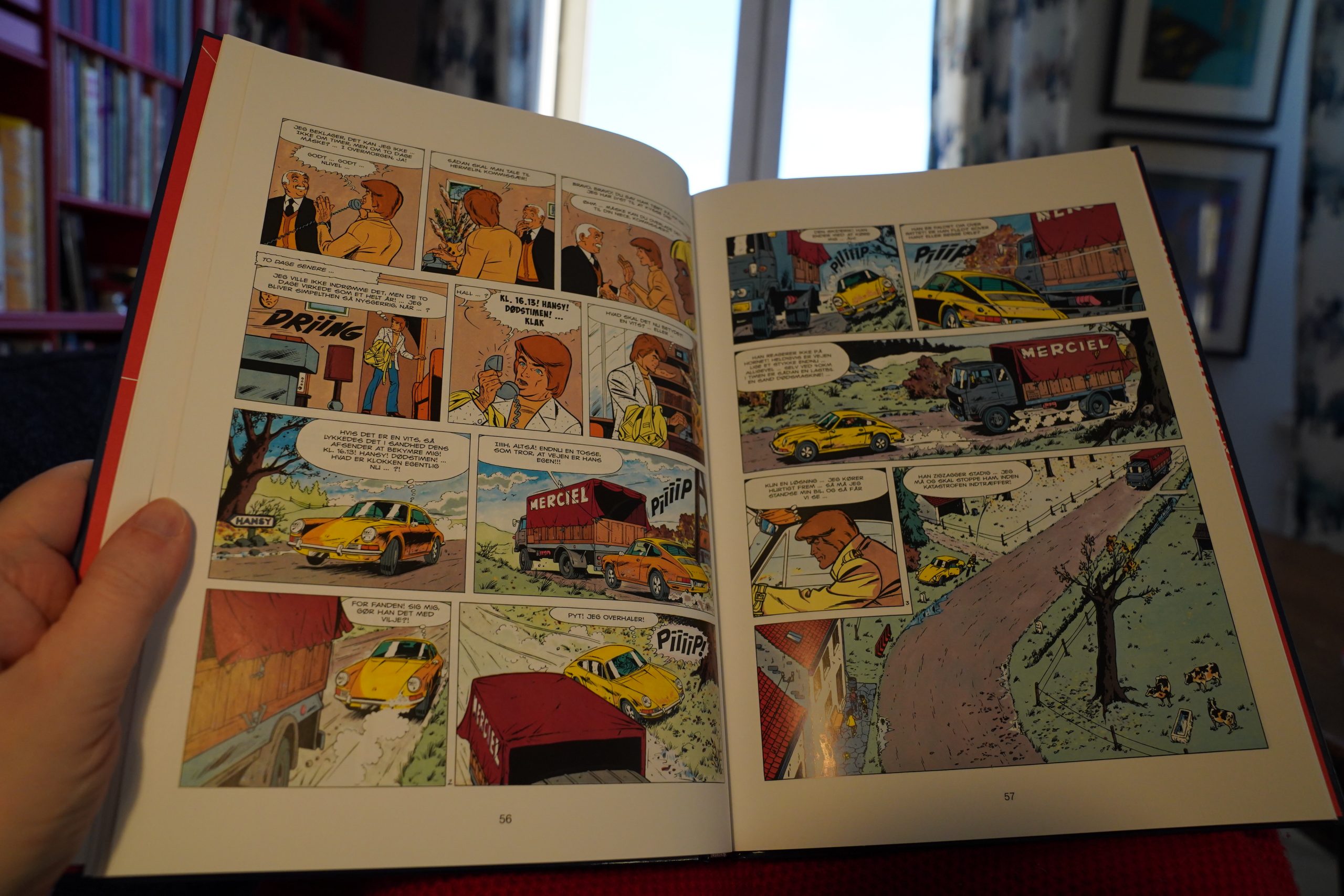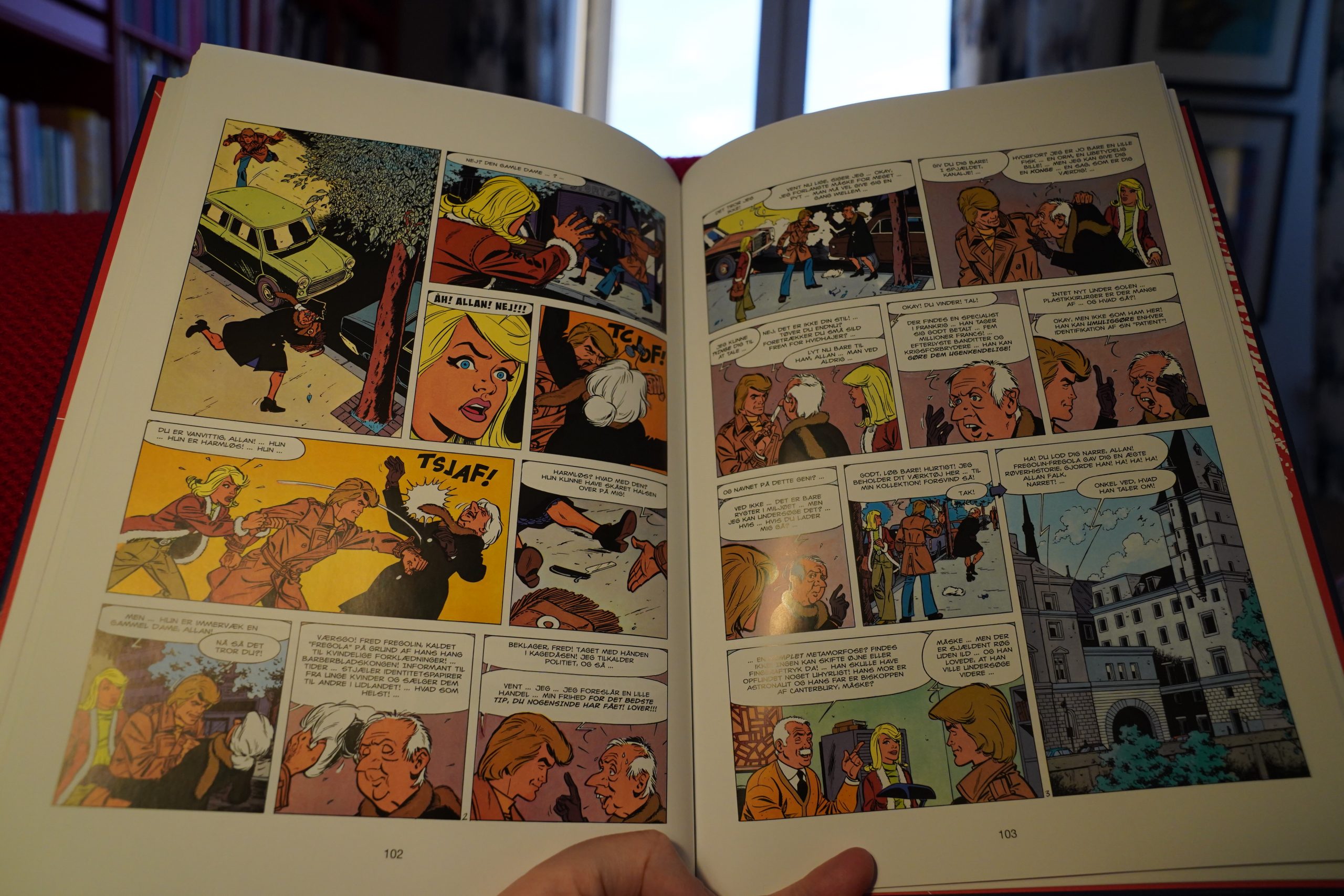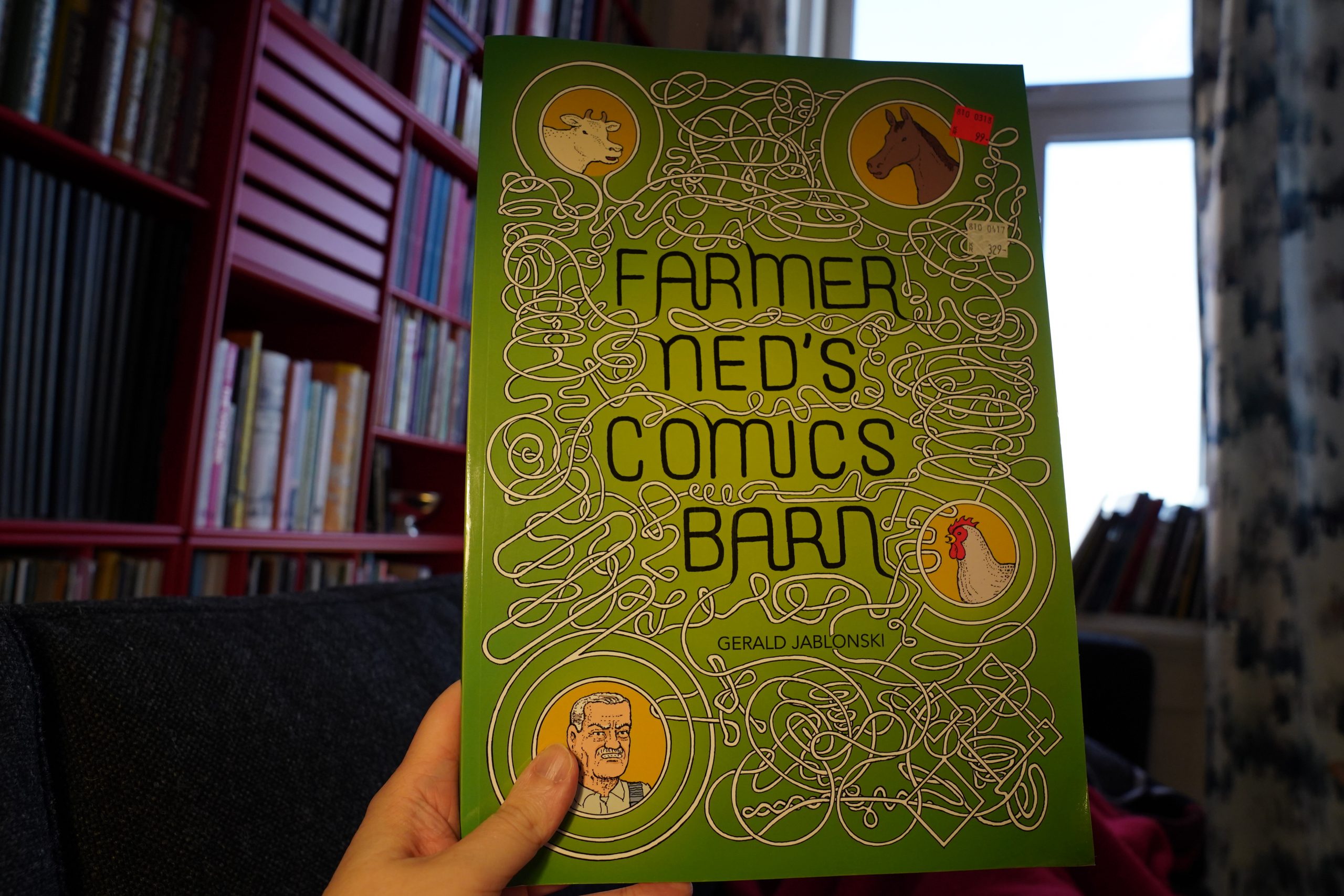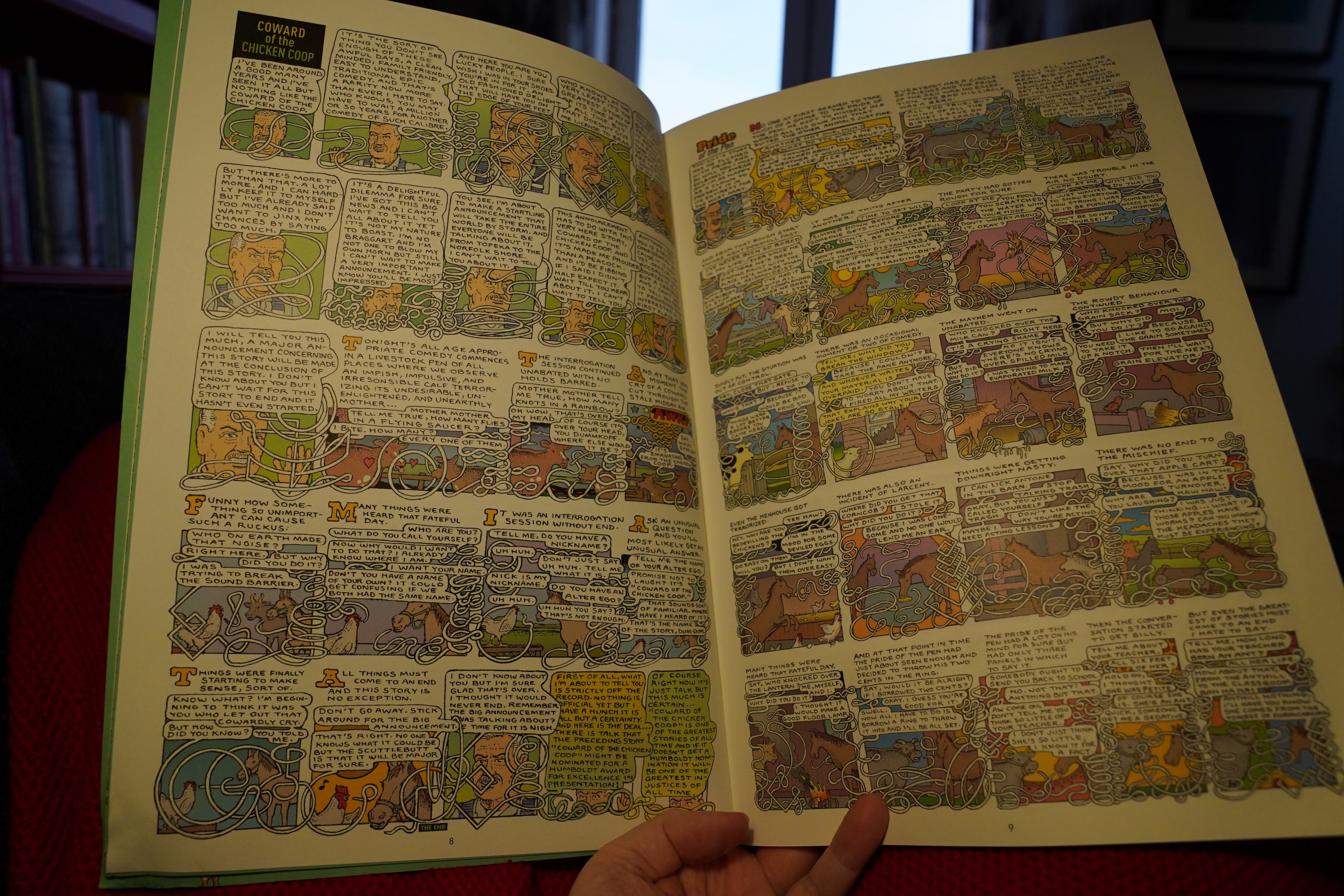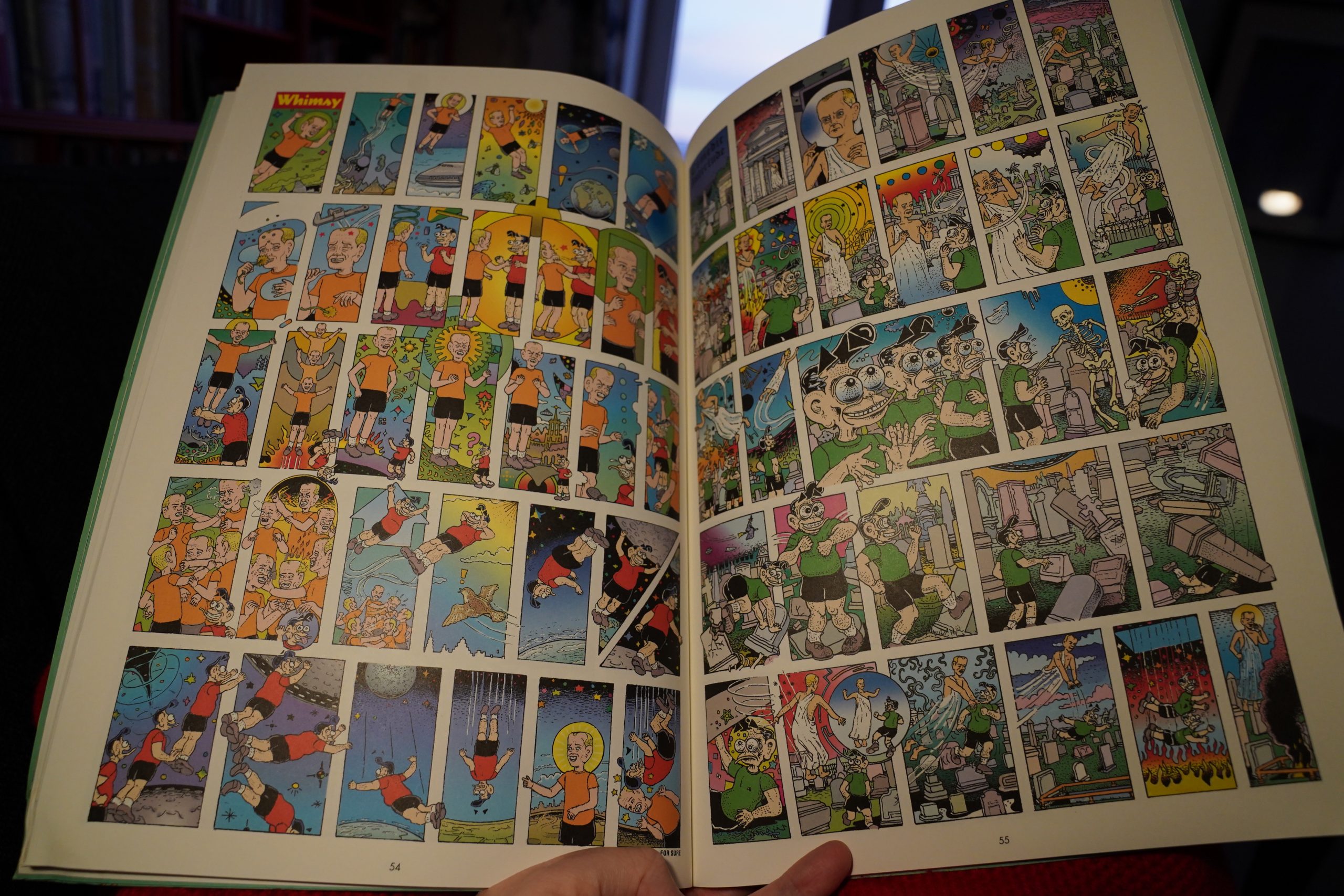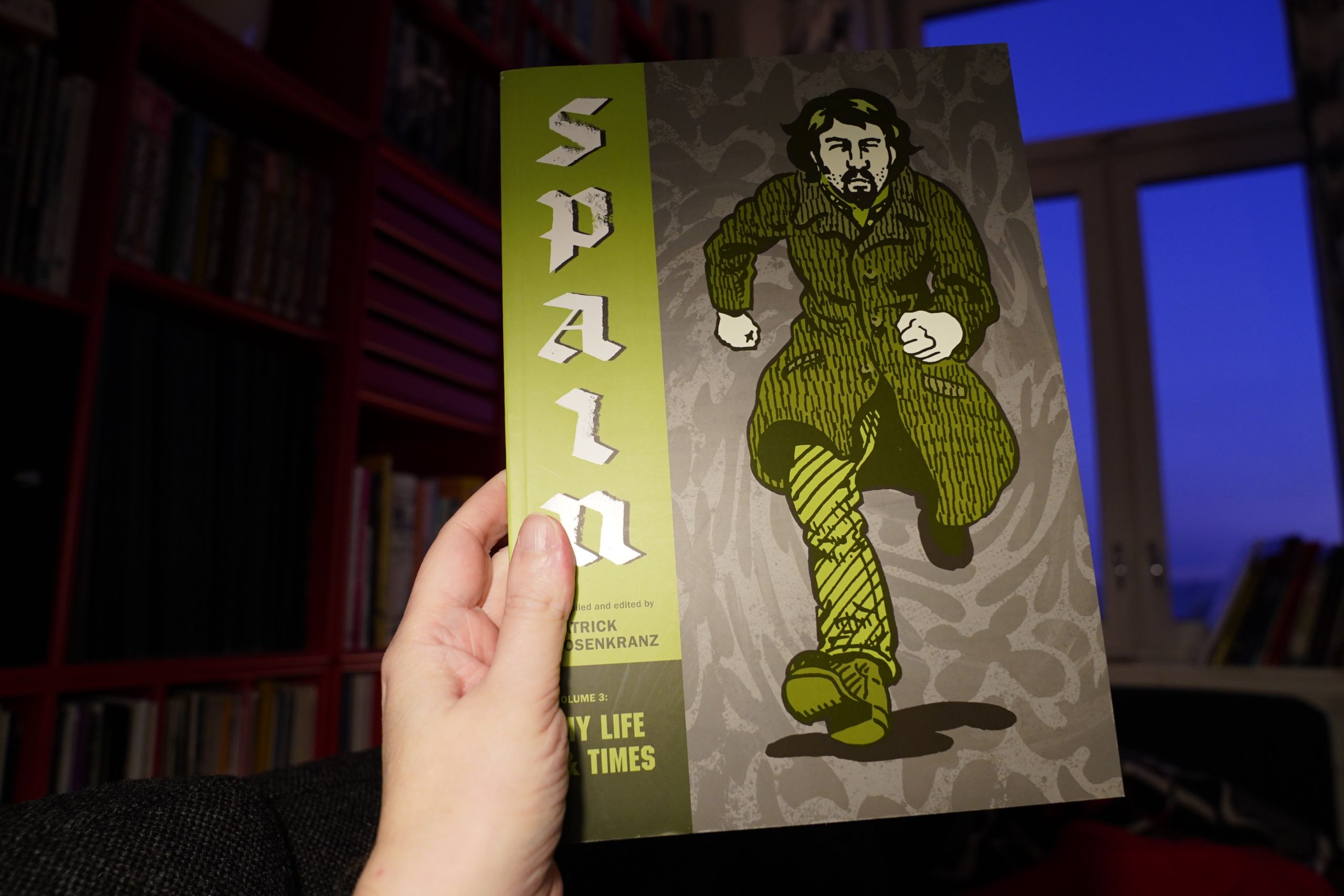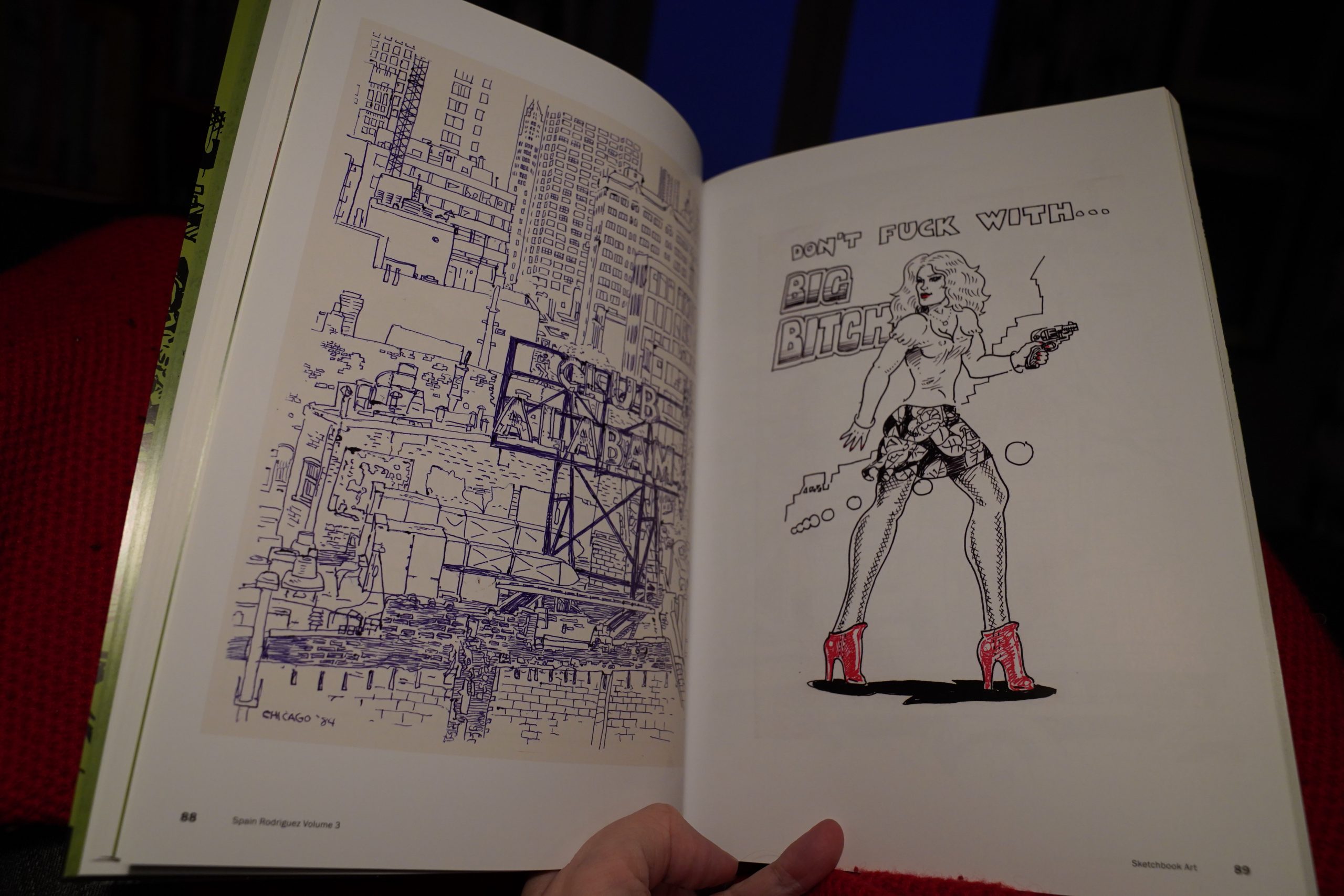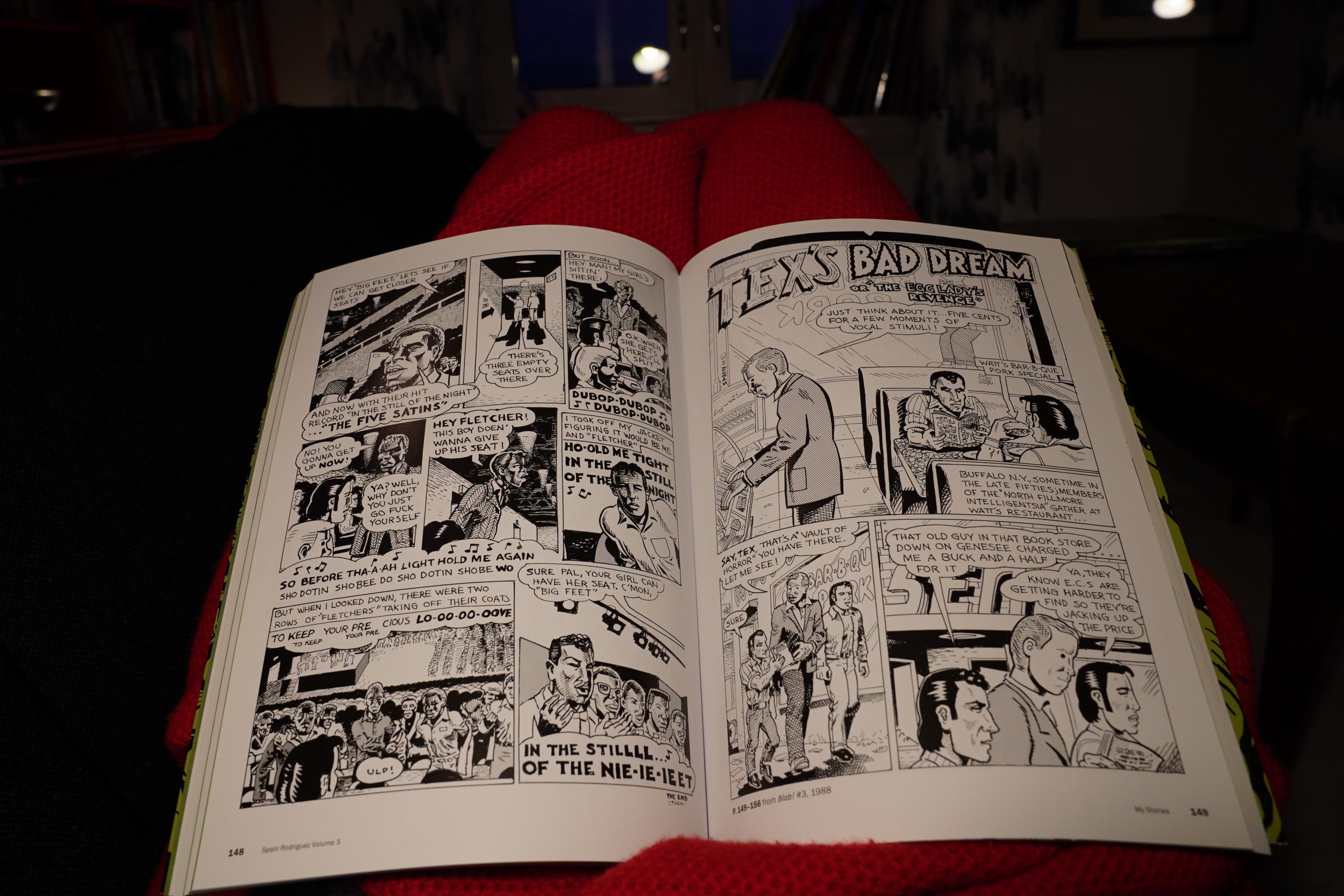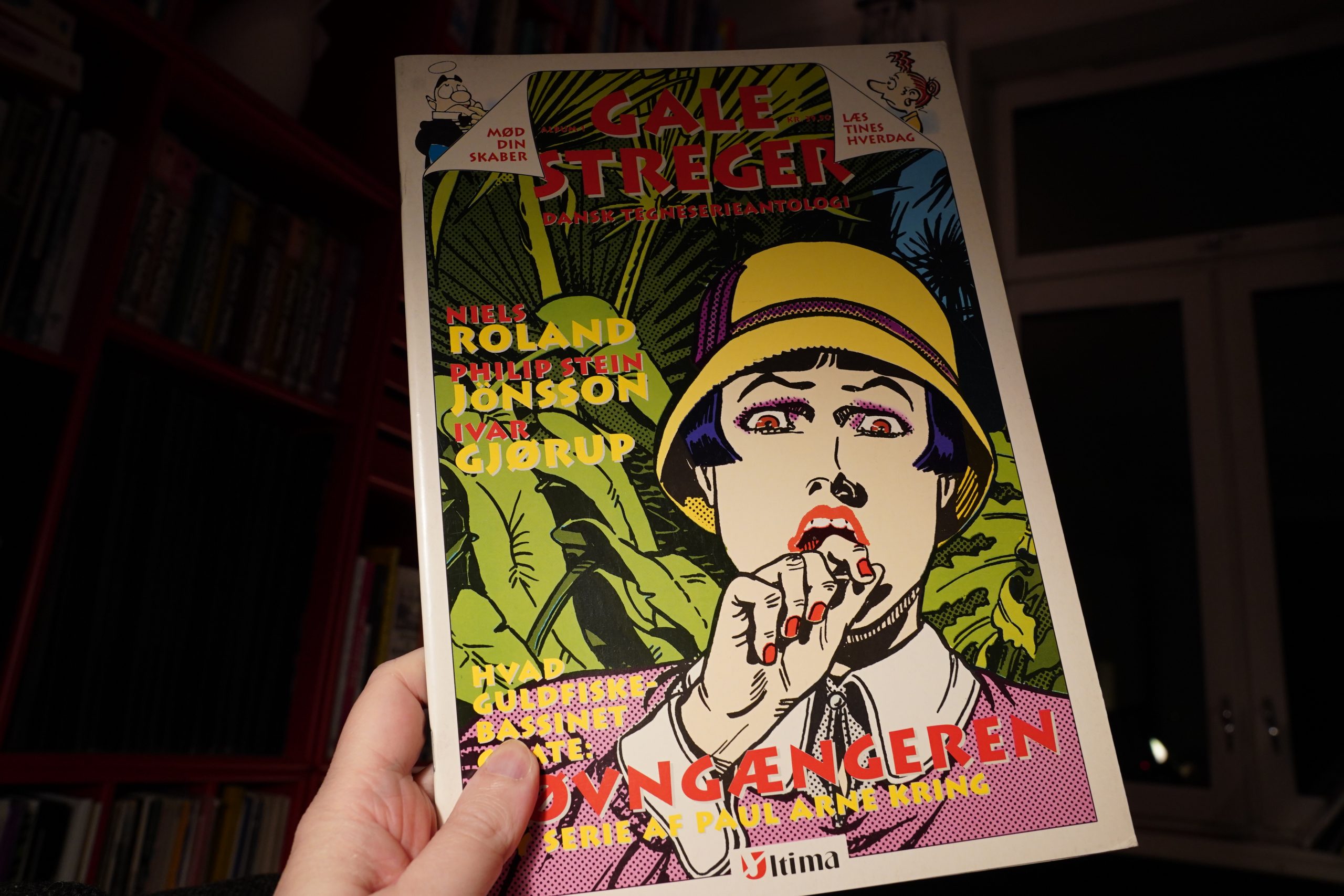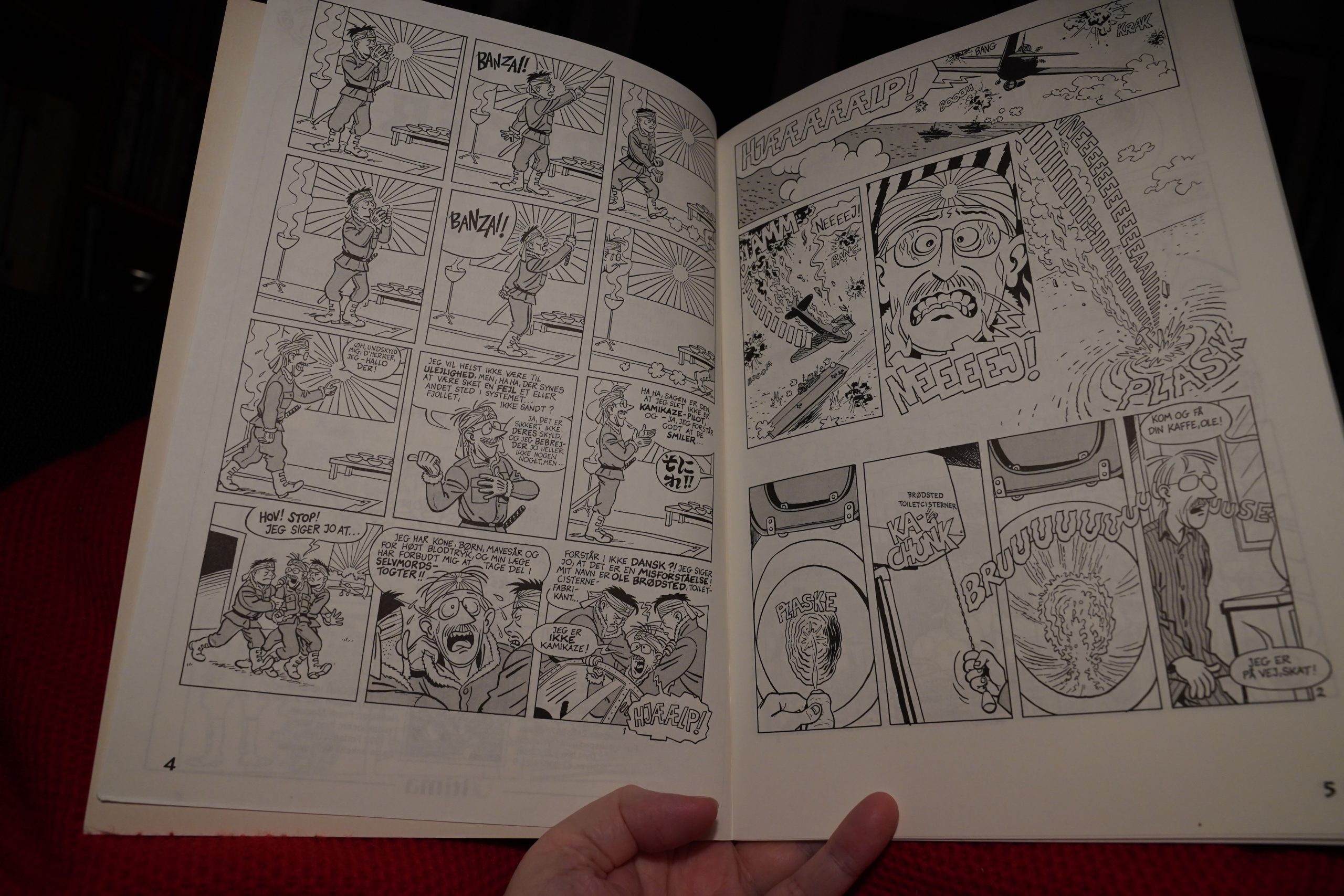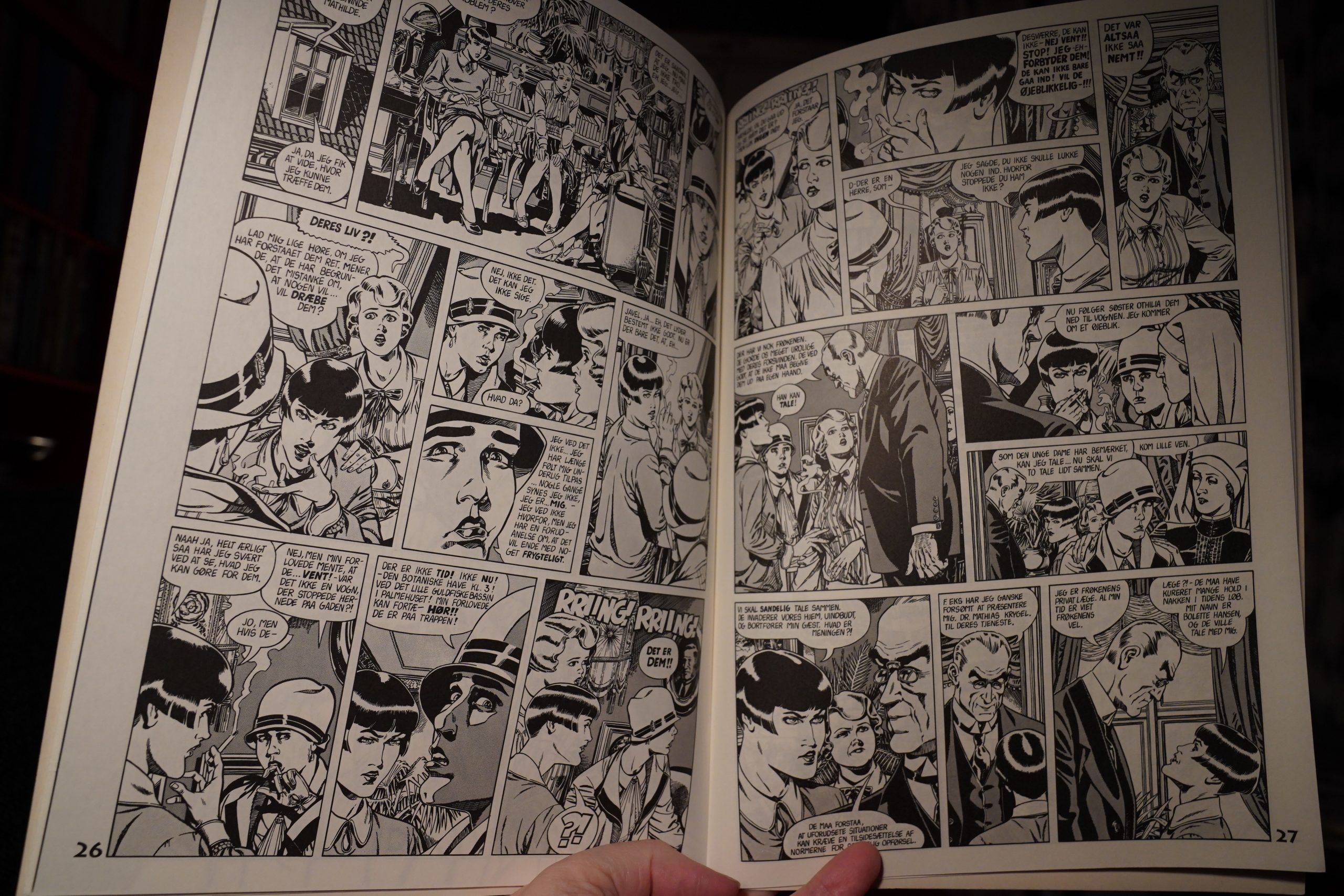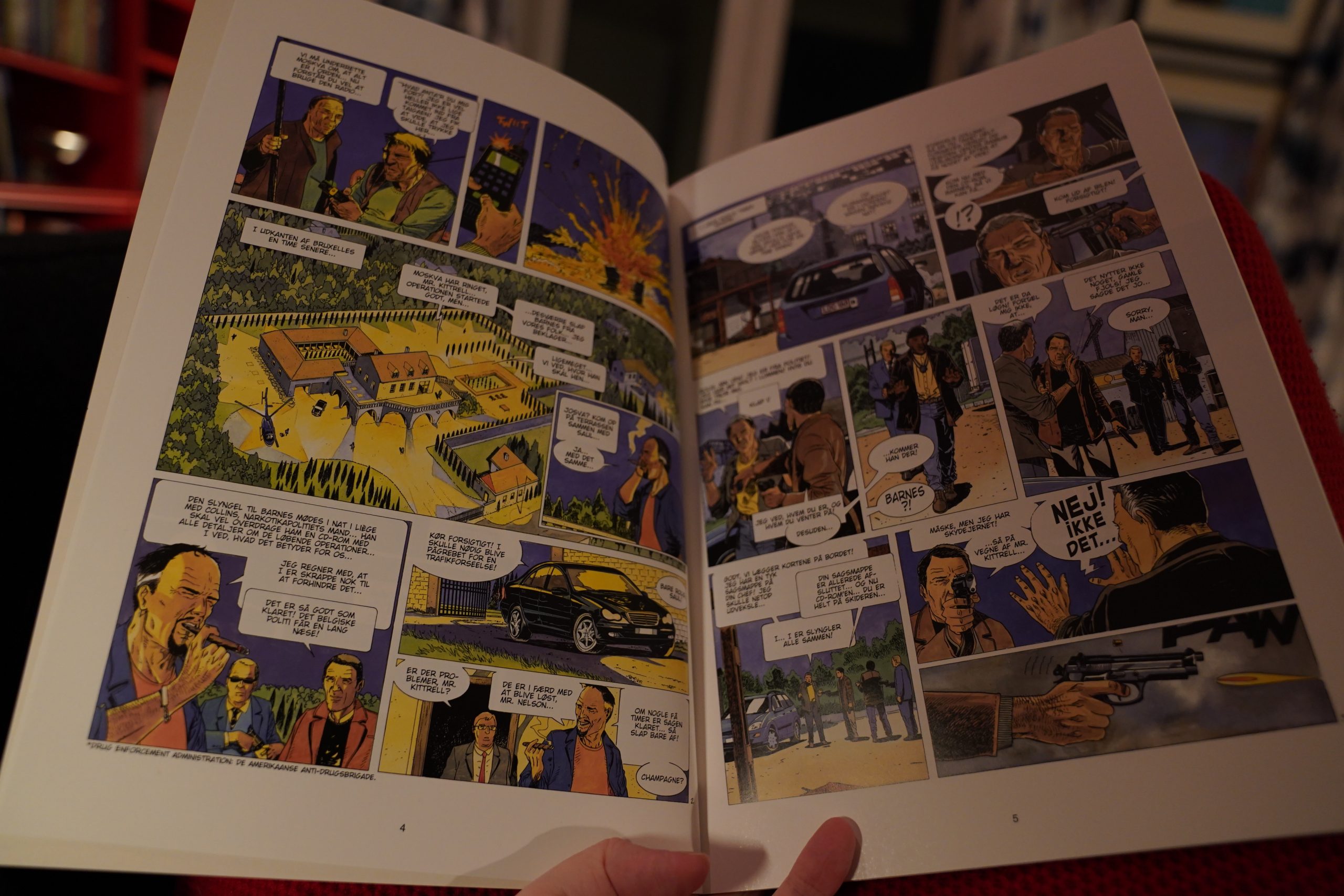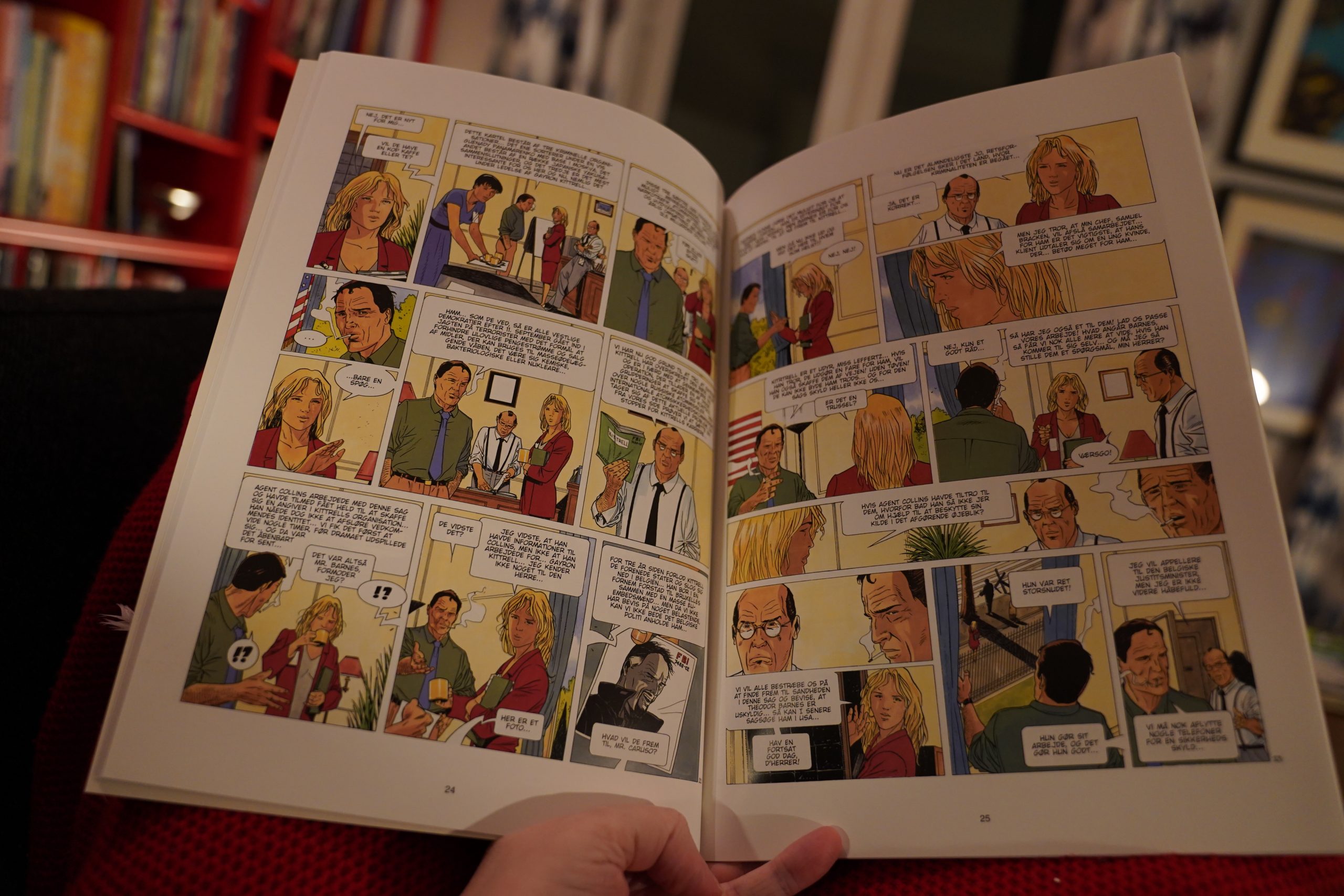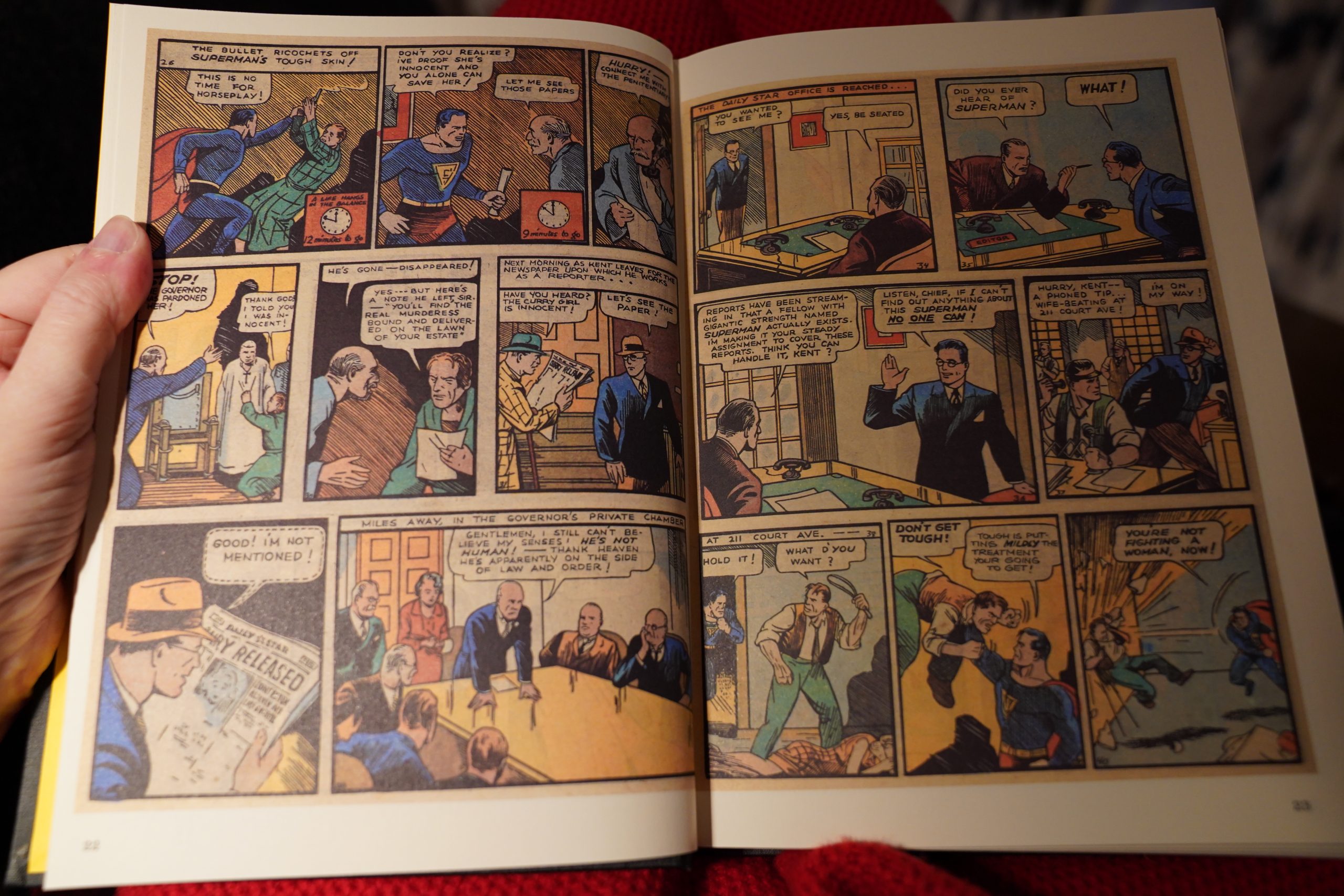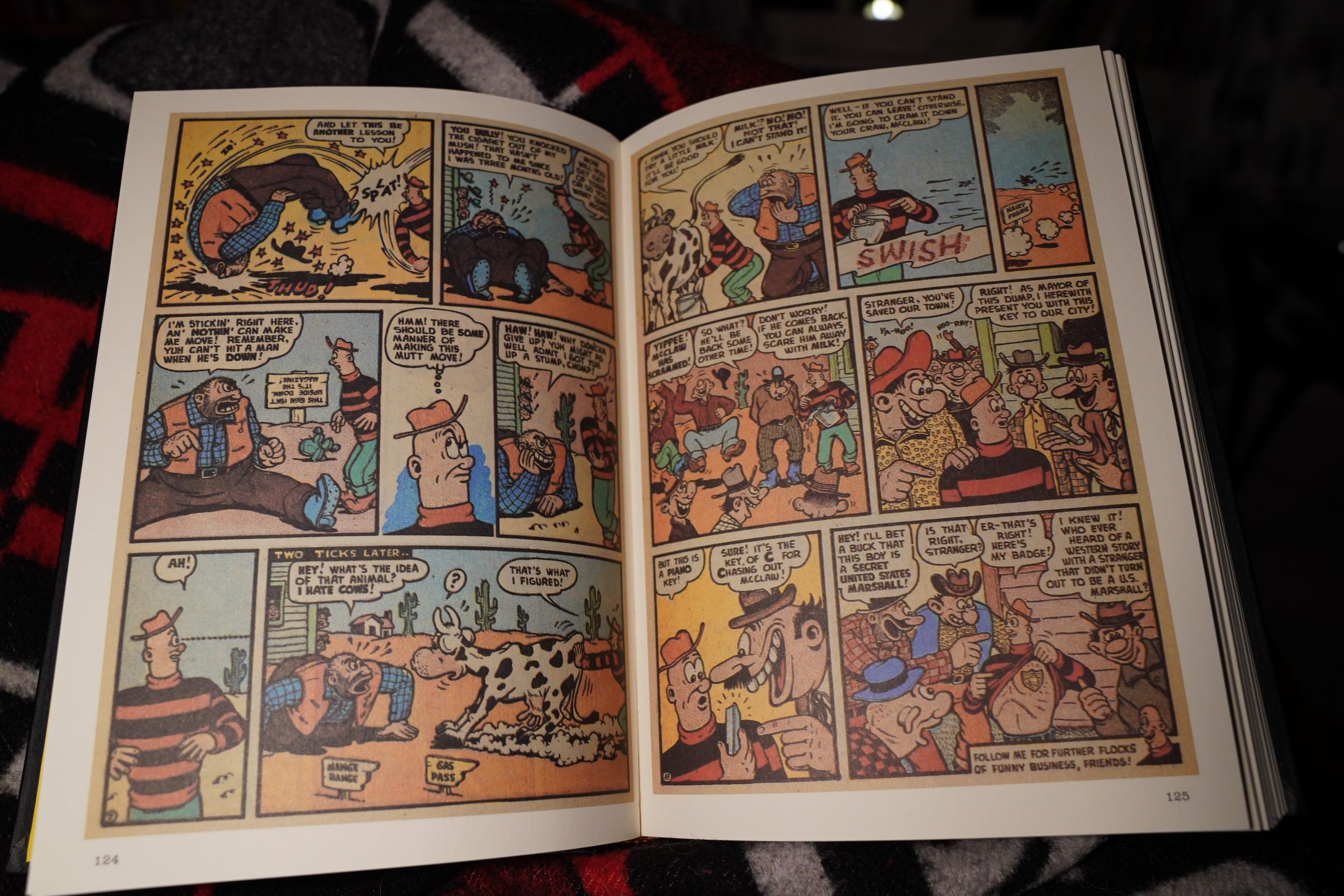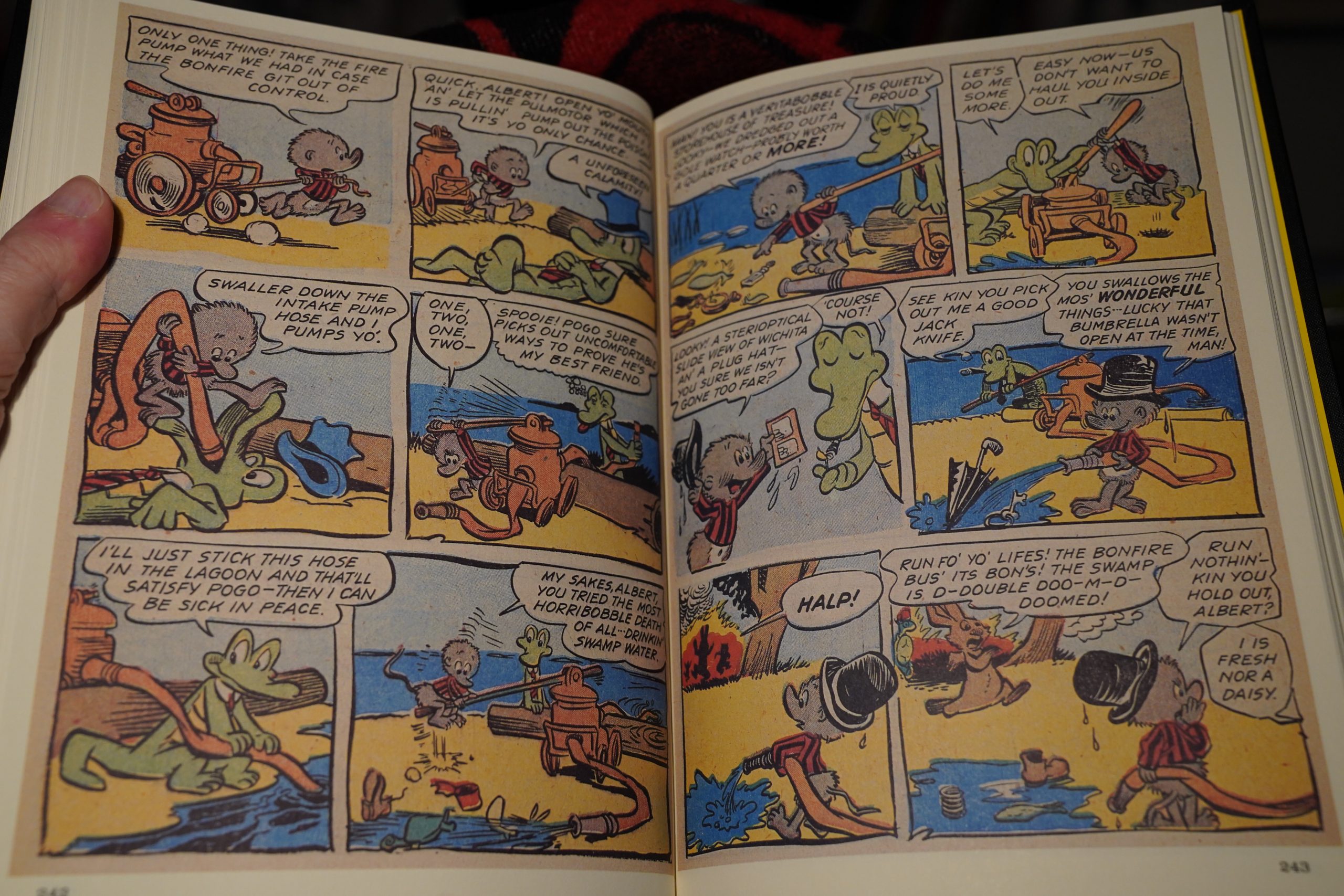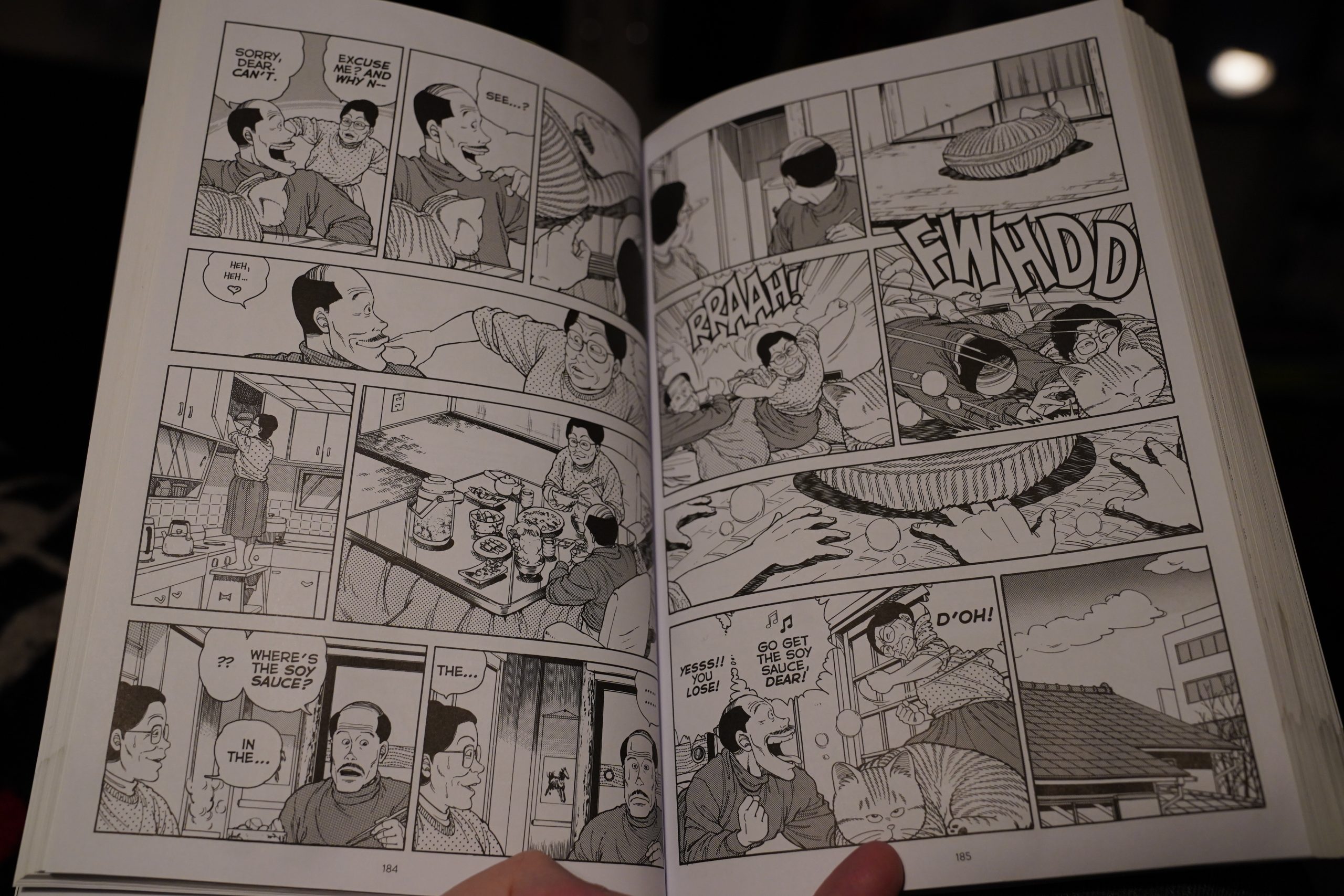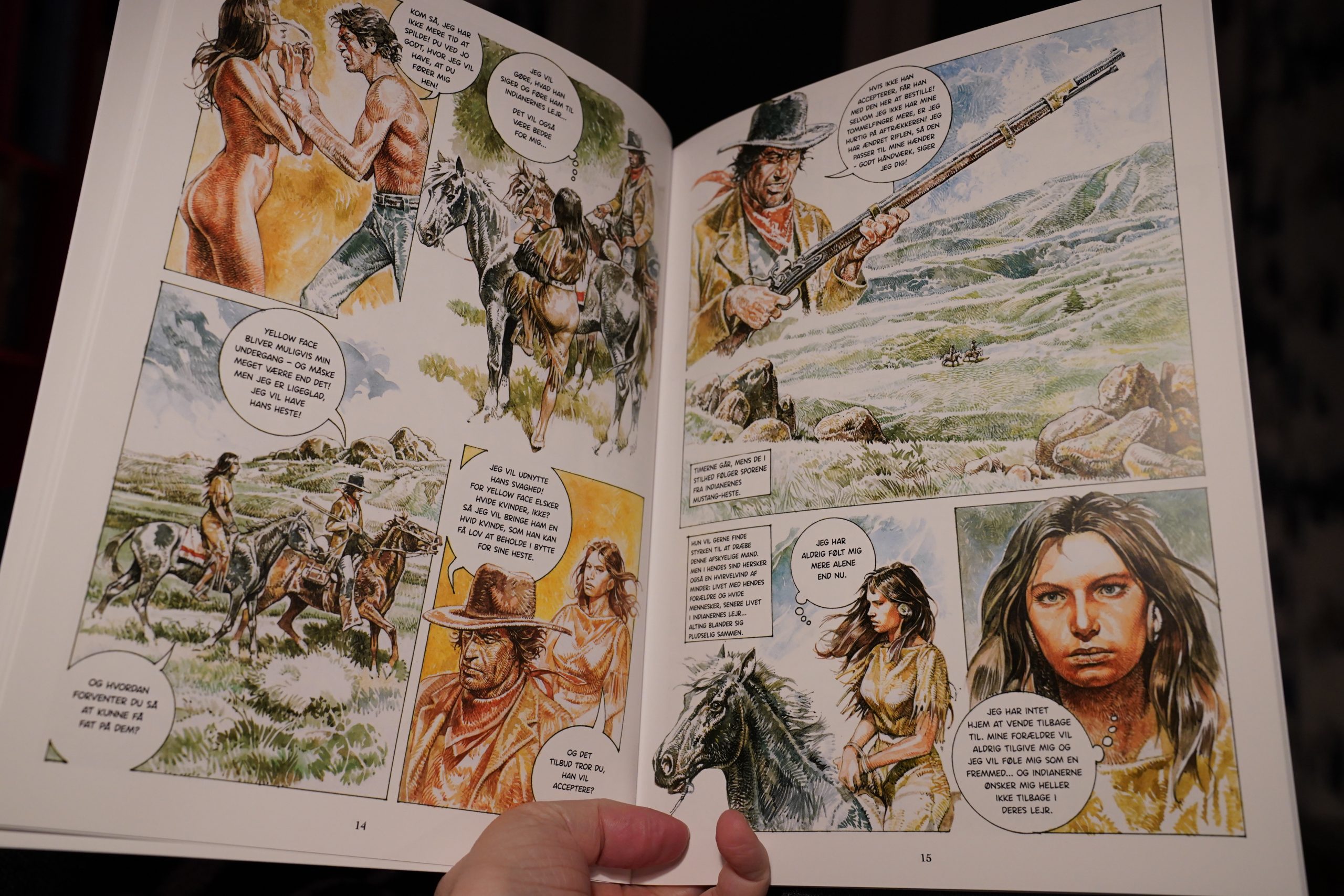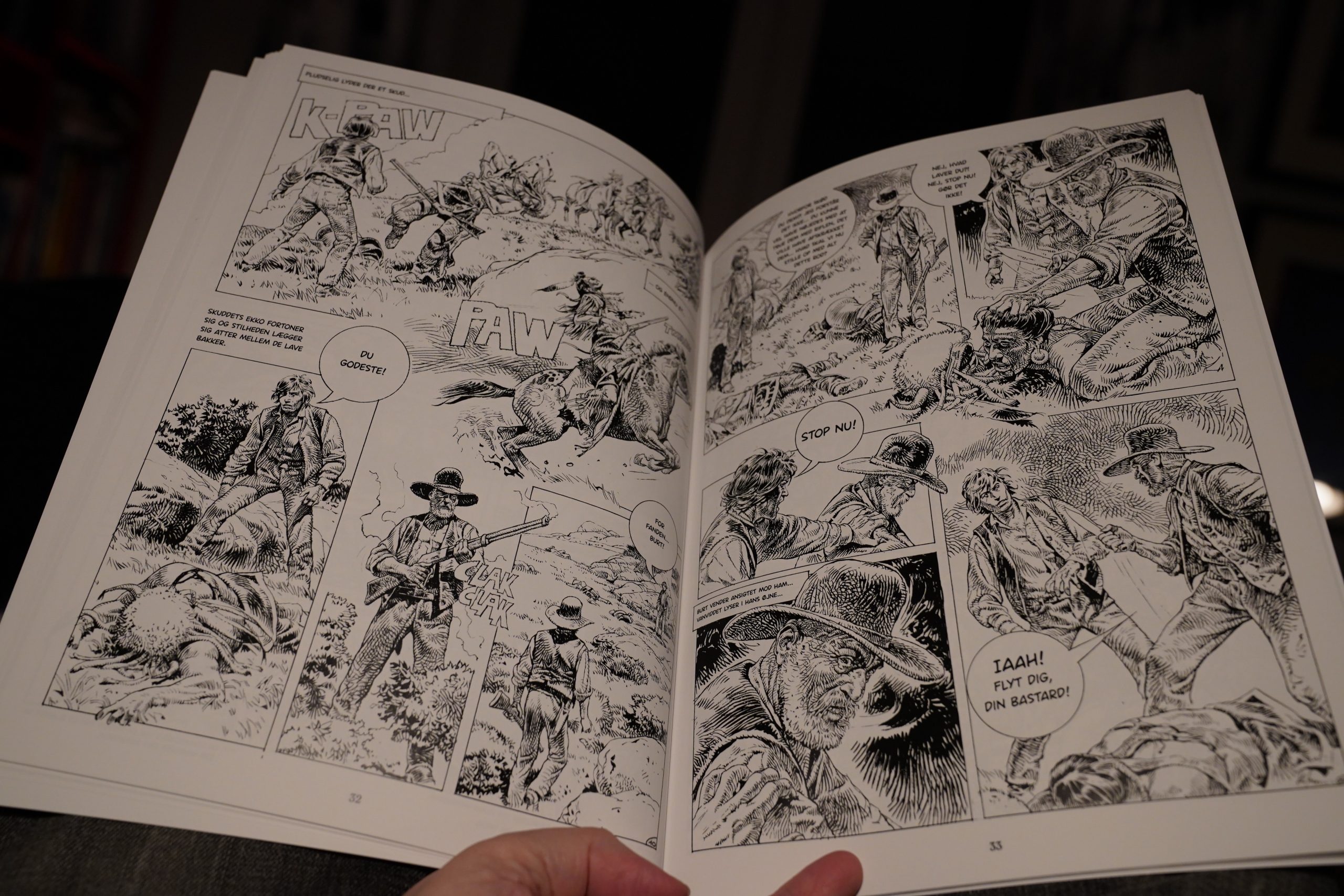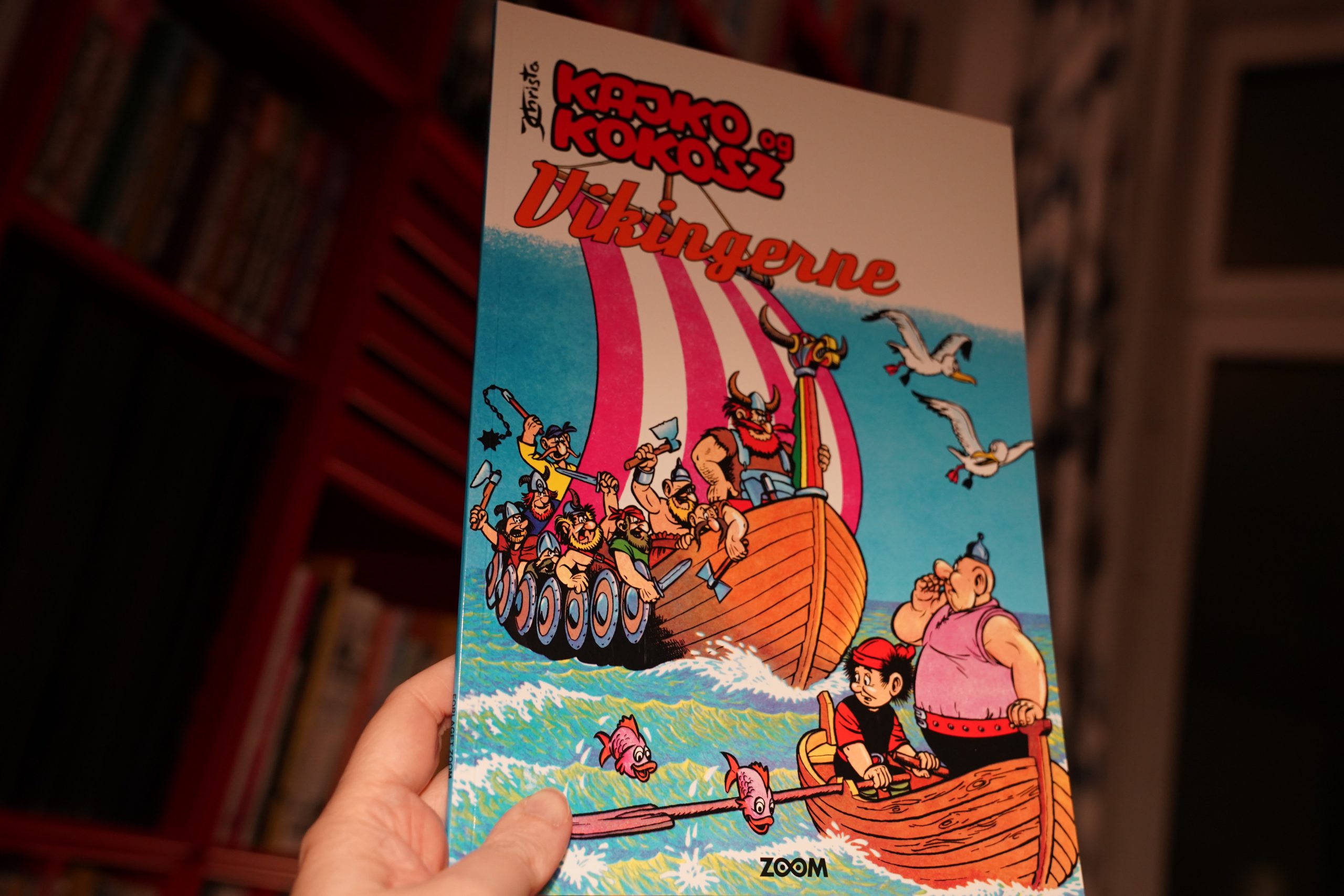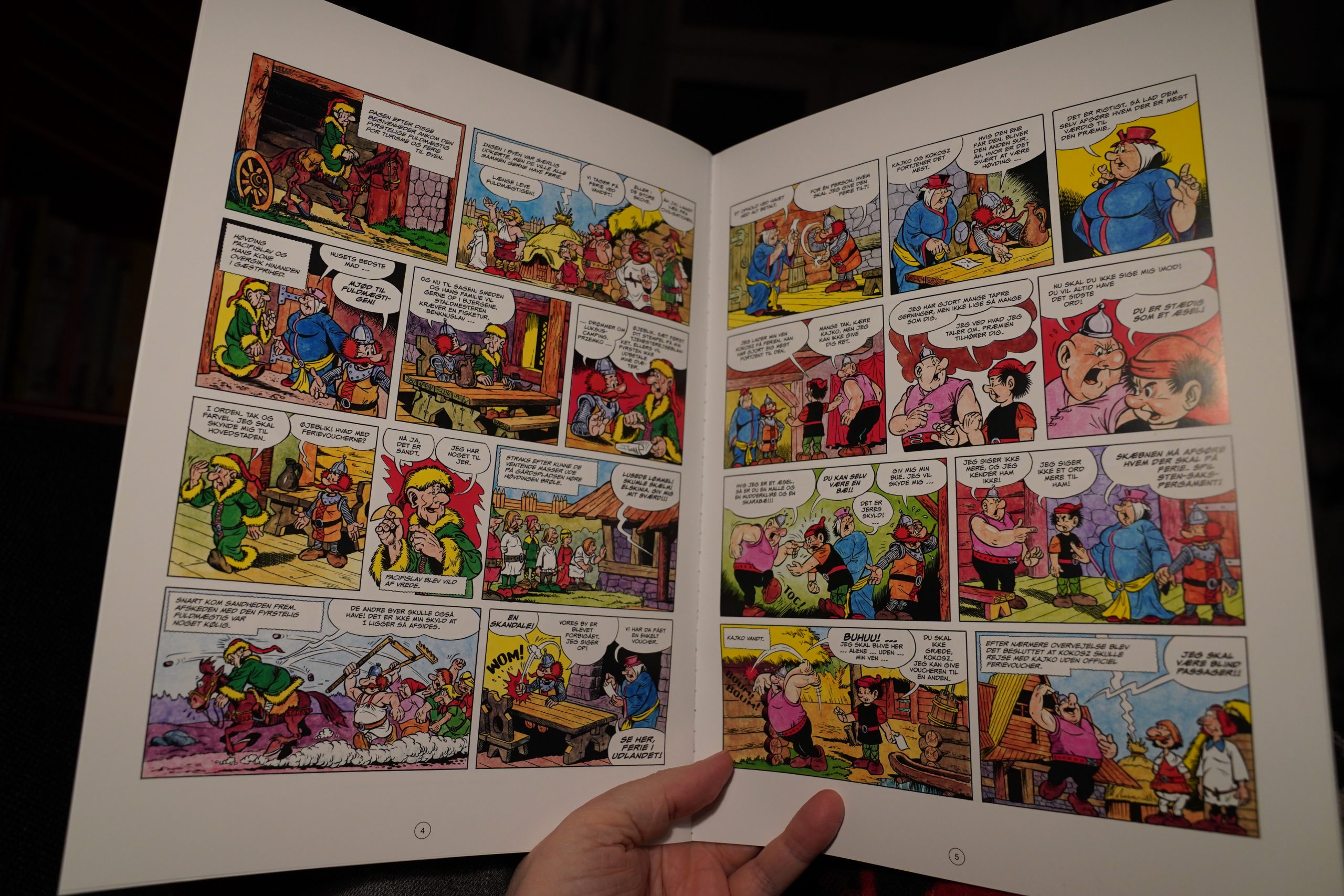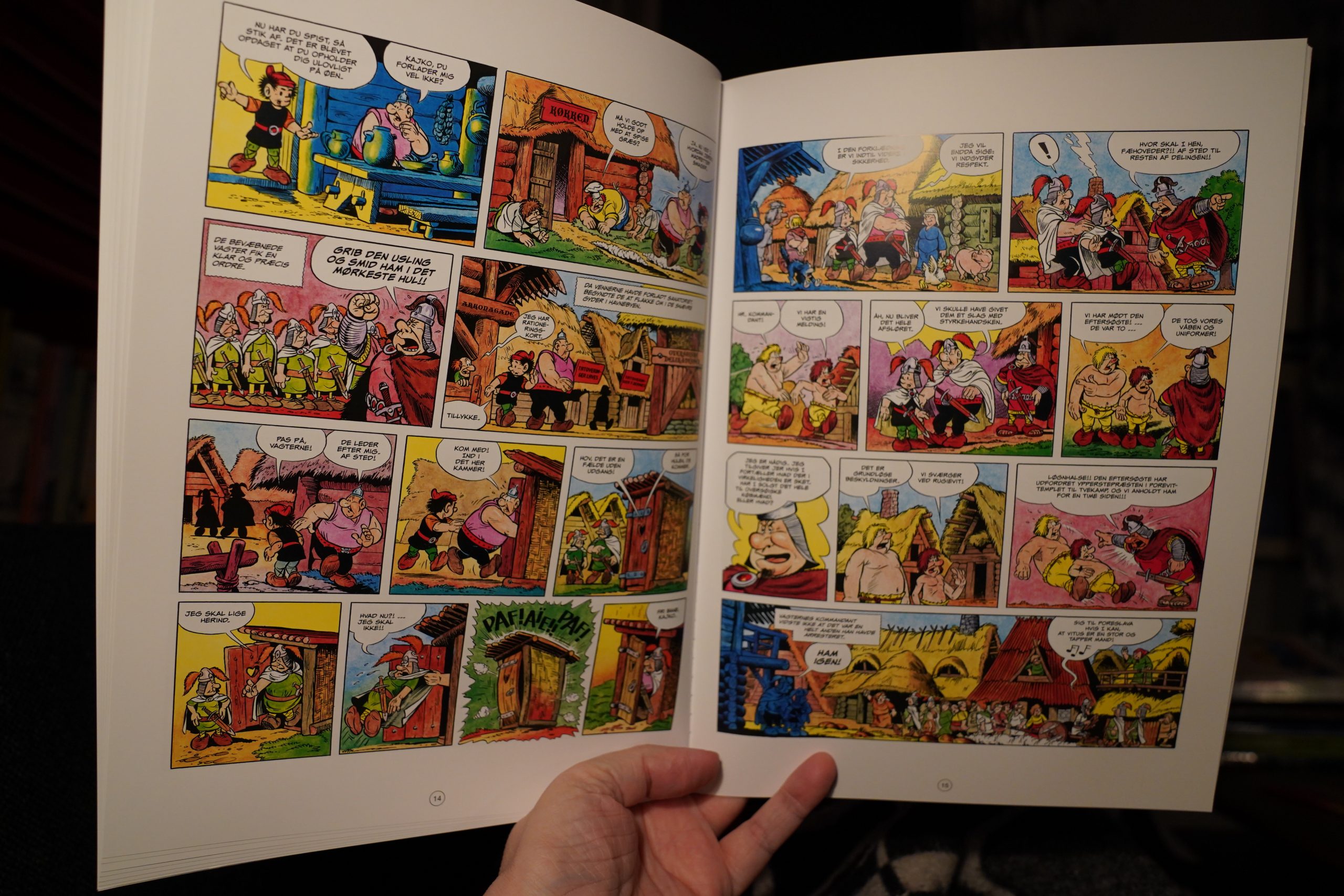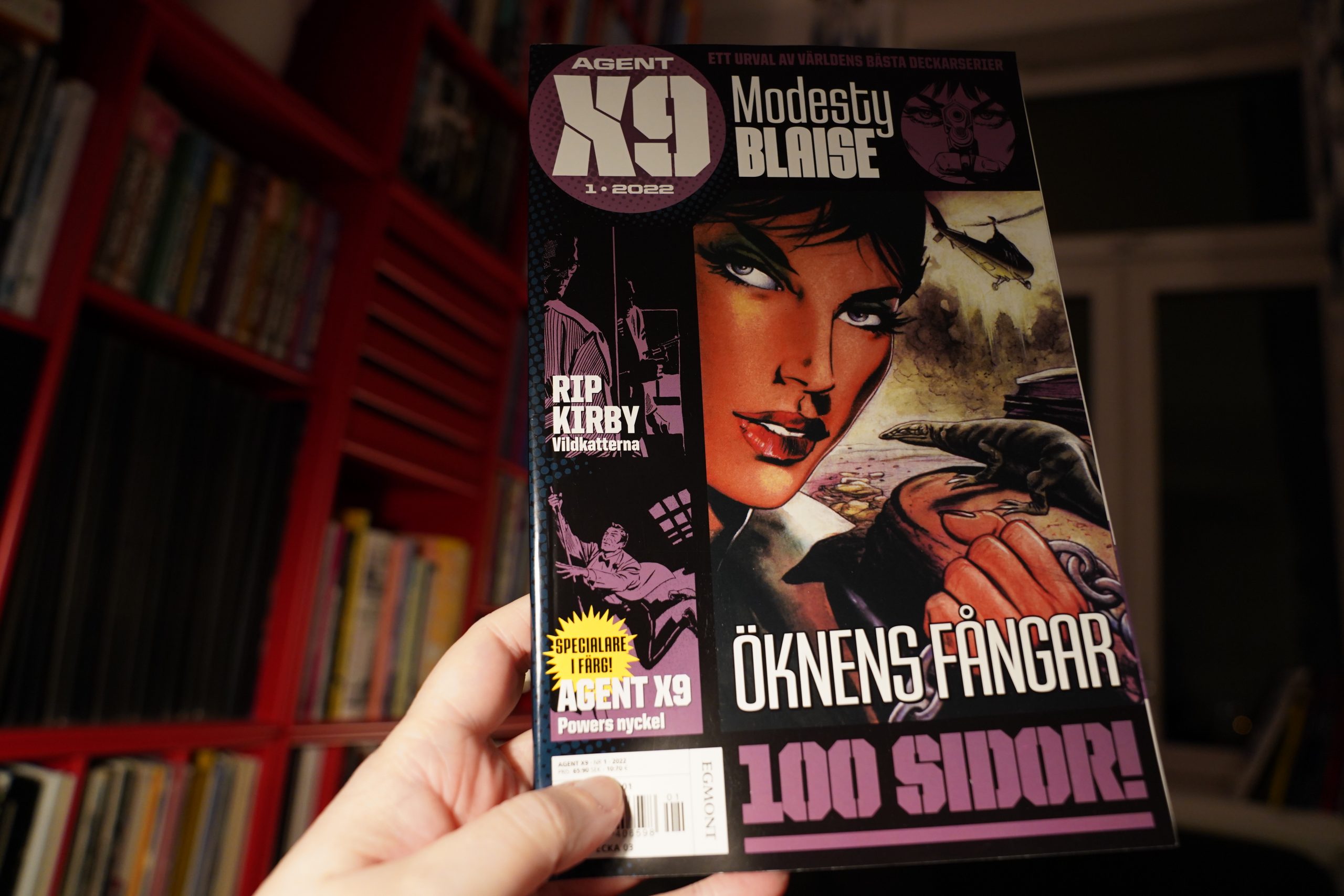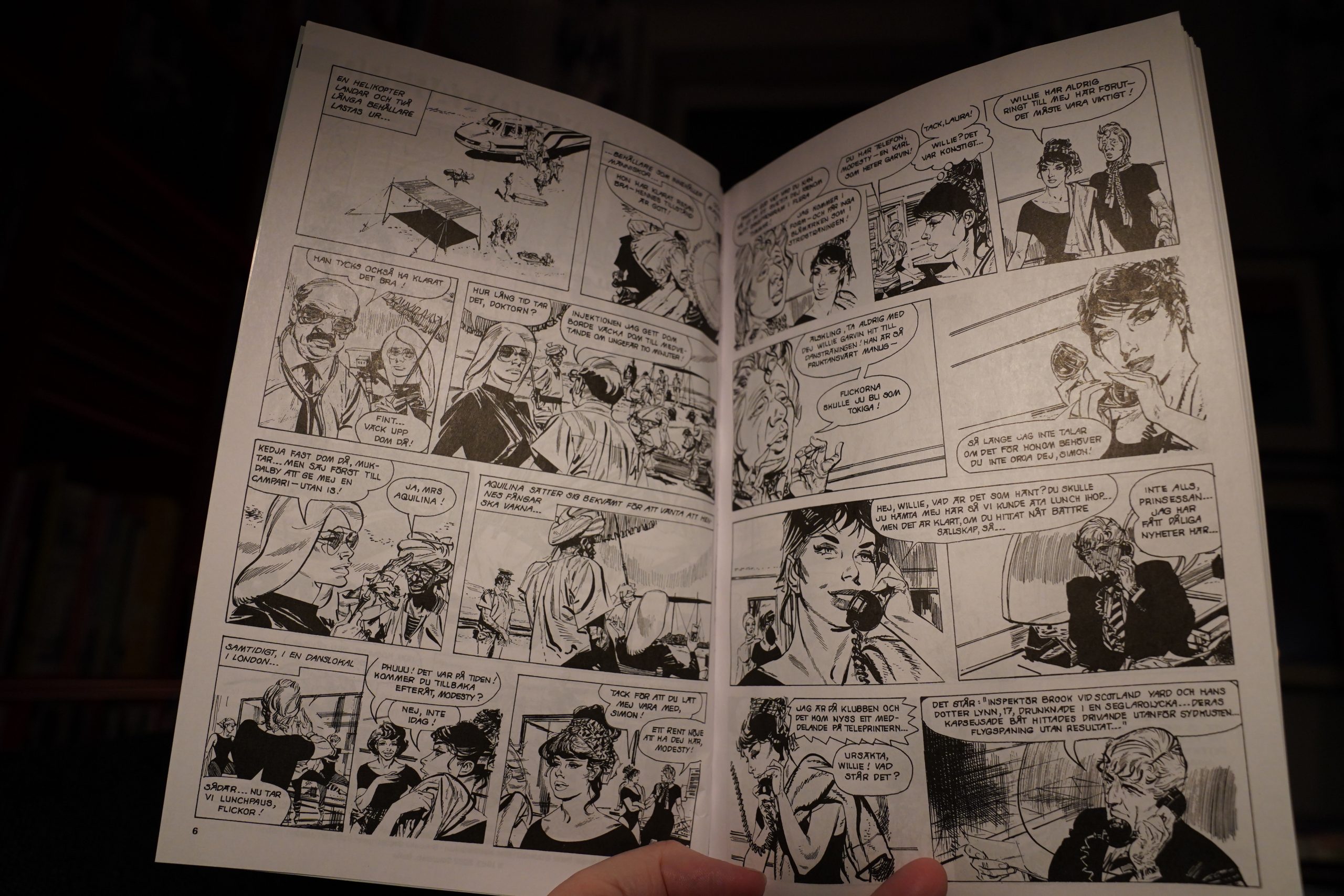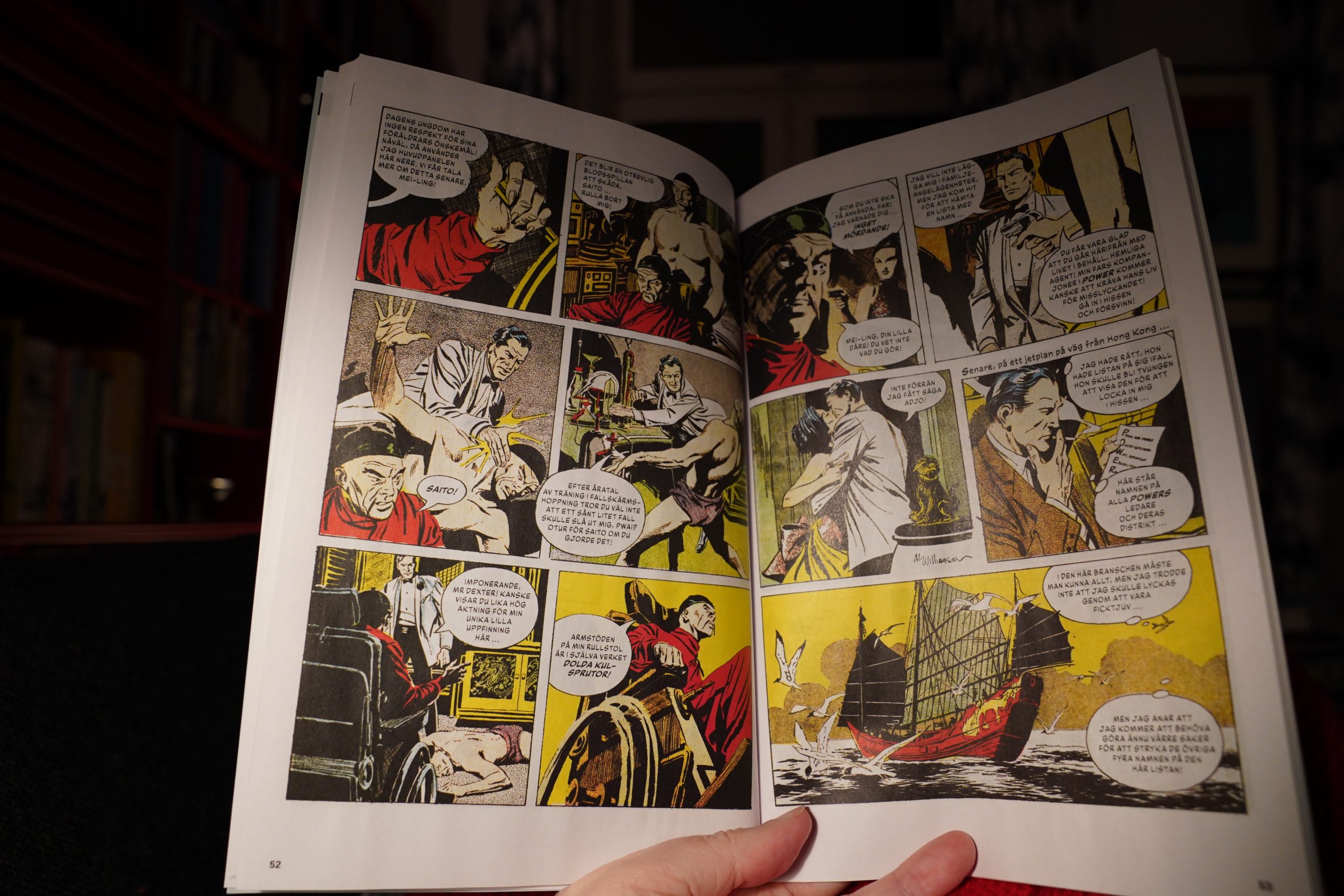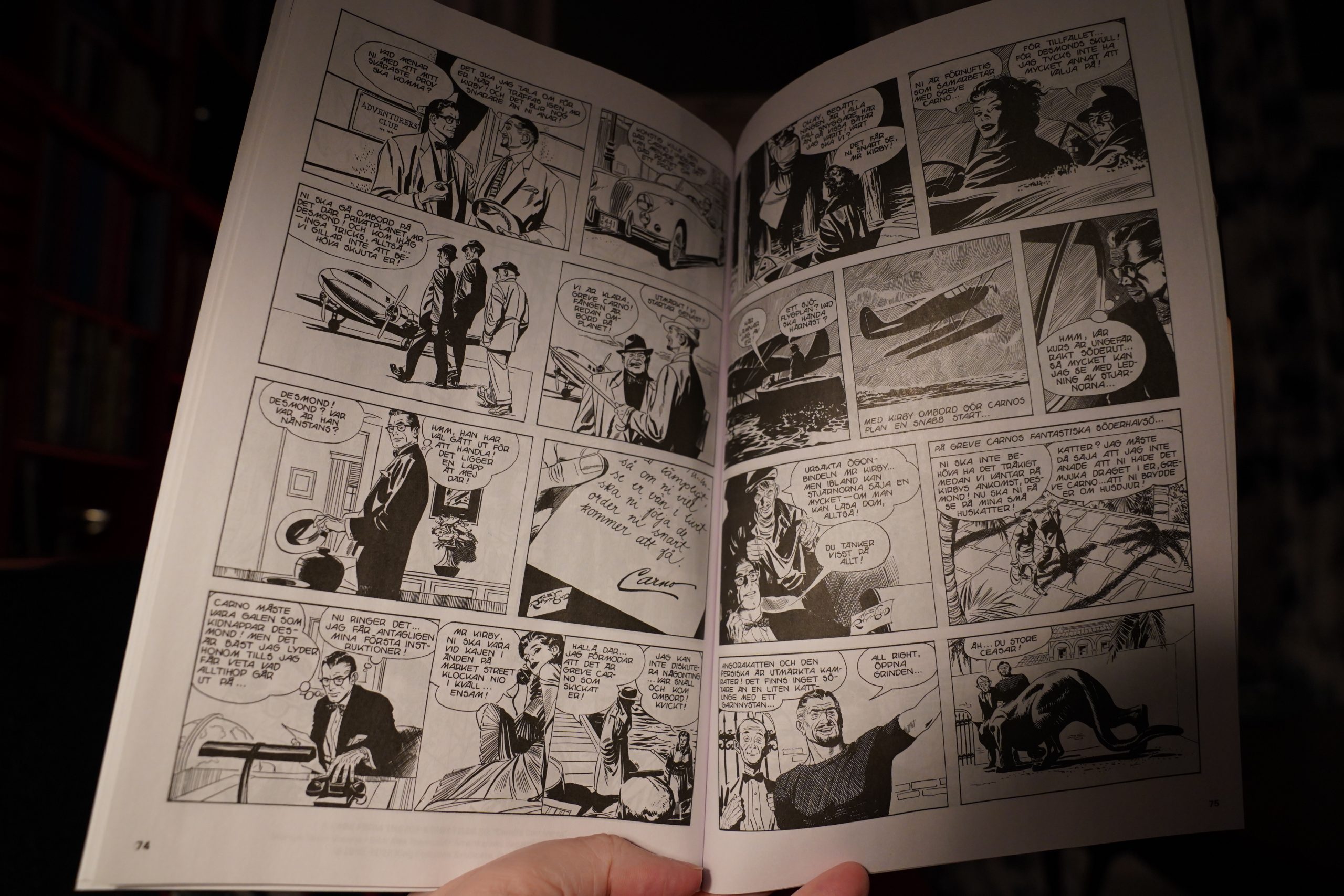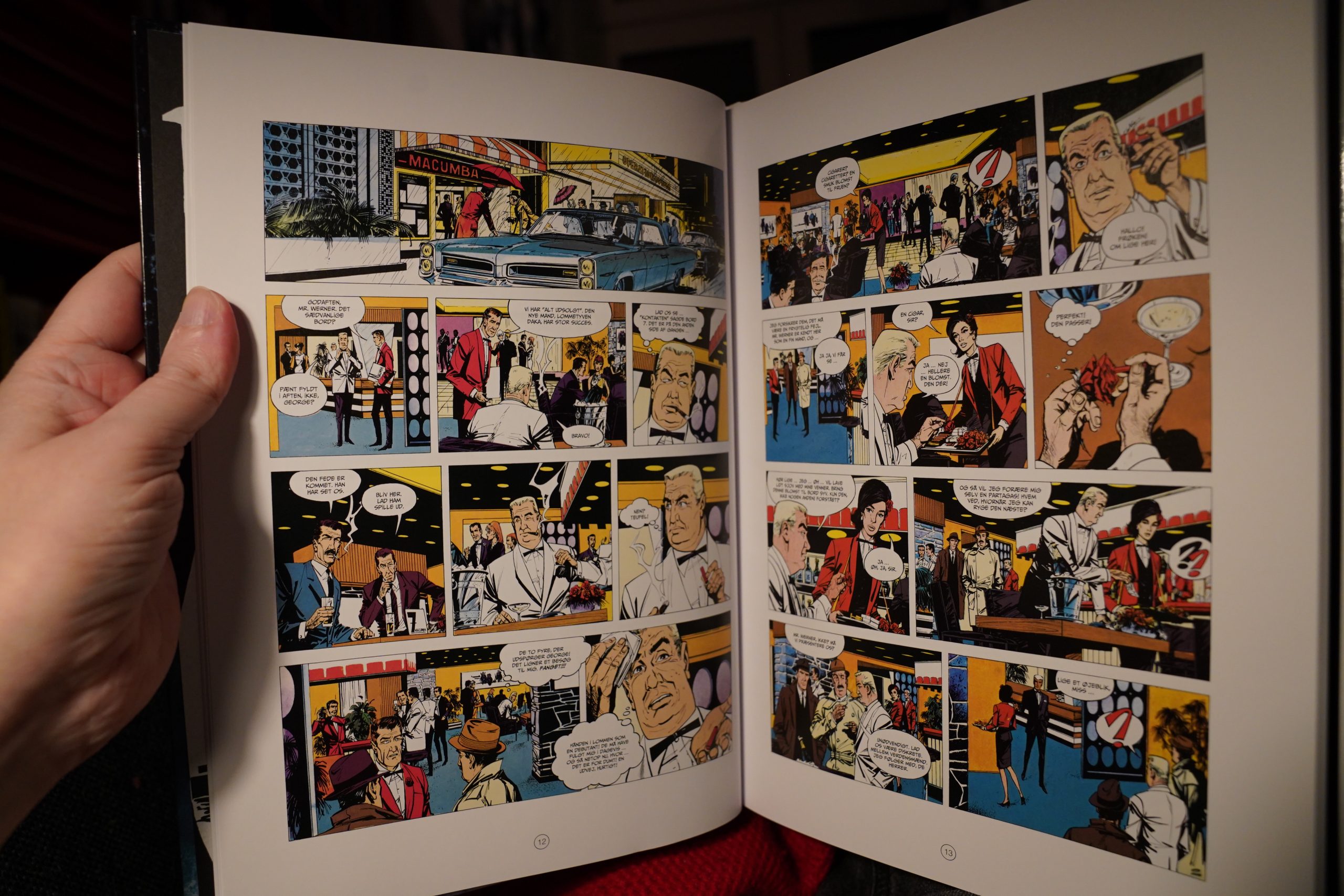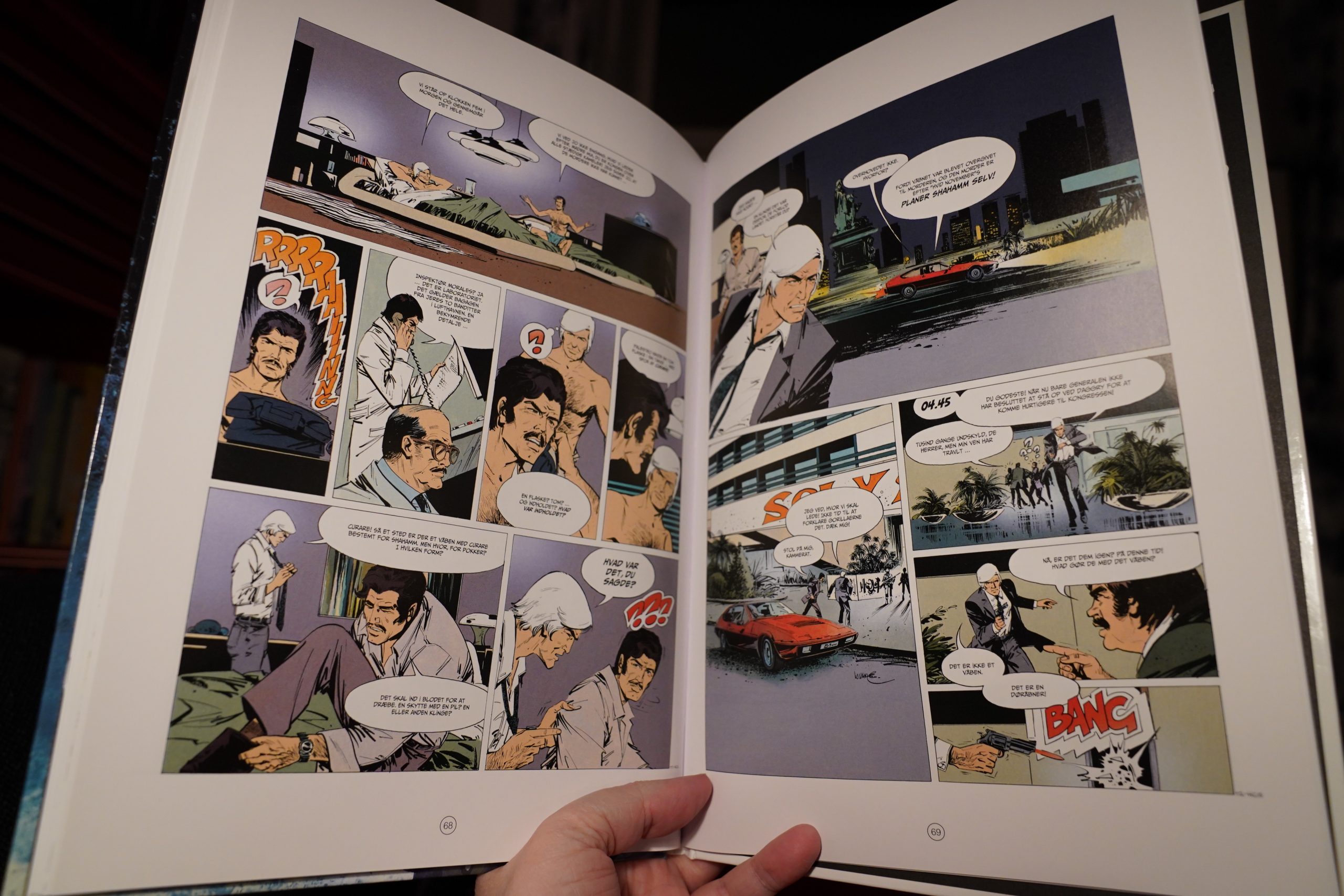I wasn’t going to do another comic reading day right after doing one, but since I’ve gotten a new couch, and the remaining unread comics are totally blocking the view from where I’m sitting now, I just have to read them to clear that.
Makes sense? No? Well, welcome to my life.
| Bertine Zetlitz: Morbid Latenight Show |  |
13:31: Ric Hochet 1974-1975 by Tibet & Duchâteau (Zoom)
I wasn’t going to buy these… but then I placed an order for about a decade of these collections. I’m amazed that there’s a market for these, and so were apparently the publishers, too, it sounds like. But there must be a lot of old, nostalgic people in Scandinavia.
I started reading this collection the other day… the attraction here is, of course, Tibet’s artwork — it’s so late-60s/early-70s, with proper interiors (draw by assistants, I think?) and cars and hairdos.
The plots (by Duchâteau) are… the problem. They’re convoluted, impossible messes, with way too many coincidences and villains involved. I mean, I realise that these are comics for teenagers, but still. And they made so many of these albums — almost 80, from 1963 to 2010, which is… almost two per year? Way more than all the other semi-classic French(ey) strips for teenagers.
And Tibet was also drawing a Chick Bill album per year at the same time, so… he was a busy guy.
| Marianne Faithfull: A Child’s Adventure | 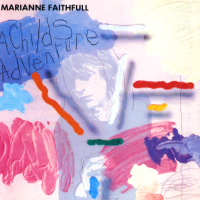 |
The final story is much better — it’s properly nightmarish, and has a plot that’s kinda clever.
| Lost Girls: Menneskekollektivet |  |
14:30: Farmer Ned’s Comics Barn by Gerald Jablonski (Fantagraphics)
Jablonski has a singular vision. Pages and pages of this hypnotic semi-nonsense — most of the dialogue are vague routines from skits, repeated over and over again, and the puns keep on coming. It’s something so behold.
Hm. Were some of these reprinted from Empty Skull Comics? At least some of this seems familiar, especially the later thing with the kid and the ant.
It’s kinda fantastic? And amazing? But also exhausting.
| Jane Siberry: No Borders Here |  |
15:48: Spain vol 3: My Life & Times by Spain (Fantagraphics)
The first … two thirds? The first half? of this book is illustrations and sketchbook stuff. It’s fine, but…
But then there’s over a hundred pages of Spain’s autobio stuff! I love this stuff! The artwork’s so sharp and the anecdotes are entertaining. I’ve read all of the stories here many times before, I think, but reading them all in one big gulp is a good reading experience.
I think this has to be the best of the Spain volumes? Nine thumbs up.
| Jane Siberry: The Walking |  |
17:17: Gale streger edited by Fred Madsen (Ultima)
Man, I’m finding weird stuff hidden in between the other books… this is apparently a Danish magazine from 1992? I have no idea how I’ve gotten this.
There’s some shorter pieces in here, but there’s two longer things. Niels Roland’s toilet salesman thing is pretty inventive.
And… I’ve read this before! What are the odds. Paul Arne Kring’s Bolette — I think I read this last year? The rendering is totally on point, but the figures themselves are pretty wonky.
But I’m not rereading this now.
17:33: Sam Bracken 1 & 1 by Philippe Jarbinet (Arboris)
I have no idea what’s up with Arboris — they’re a Dutch company that’s published a buttload of Danish translations, and… it’s usually crap? I mean, they seem to be able to select the dregs from the general BD area and then publish them for nothing? So I picked up these two albums for about three bucks, and…
… they’re crap. The artwork’s got some kind of Hermann thing going on, but without the excitement or chops. After he introduced the (possibly) tenth male character and the (possibly) fifth female characters that looked identical to all the previous ones, I grew tired of flipping back to see whether it was really the same character or a new one.
So it’s really got that Arboris touch, and I’m abandoning this after reading 24 pages.
| Jane Siberry: Bound By The Beauty |  |
18:03: A Smithsonian Book of Comic-Book Stories by Michael Barrier and Martin Williams (Abrams)
This book has a more narrow focus than I expected — it covers basically the late 30s to the early 50s. So we start off in 1938 with the first Superman story… and I may never have read this before? It seems incredible, but I guess it’s possible? It’s a lot more vigorous than I expected.
But… while I can’t fault the selections that are in the book (except the first Batman story — that felt superfluous after including the Superman story), the selection is pretty myopic. It’s basically the standard pap pap list of stuff: It’s just super-heroes and humour strips, and none of the other genres that flourished at the time.
And even the even include Walt Kelly, even if he was mostly known for comic strips and not comic books. Perhaps the text in the book explains the editorial choices, but I didn’t read the text, so oops.
But! It’s a book that reads really well. The choices seem to complement each other and it’s got a really nice flow. And the selections vary from fine to inspired. So… well done? Yeah, I guess.
But I wonder how this book was received at the time.
Heidi MacDonald writes in The Comics Journal #74, page 32:
A Smithsonian Book of Comic-Book
Comics is at once an exhilarating and
chilling book. It is exhilarating because it
proves that the comics medium is not only
capable of but has produced work of lasting
value. It is chilling because it shows that
too much of this work may not have the
chance to last.[…]
There are the humorous heroes—Plastic
Man and Captain Marvel. There is pure
humor—Little Lulu, Powerhouse Pepper,
Scribbly, and early Mad. There are the fun-
ny animals—Pogo and Barks’ Ducks. There
is realism—Harvey Kurtzman and Bernard
Krigstein. There is the uncategoriz-
able—the Spirit, and most enigmatic of all,
Jingle Jangle Tales by George Carlson.
In their introduction the editors explain.
their criterion for choosing these stories.
“We have looked for compelling stories
whose creators have made use Of the
medium itself—who have made their words
and pictures work together to achieve
results not possible in any other medium.”
This is a high and worthy goal, and it has
been achieved.[…]
That’s the good news. Now the bad
news. The Smithsonian book was shot—
for various reasons—directly from the ac-
tual pages of the comic books. And that
means that all the flaws Of the original
pages are captured in the book. Fuzzy
printing, big screen dots, ink blops, bad
registration, and double bleed-through,
first from the original pages, and much
fainter from the Smithsonian pages. These
problems don’t occur on every page, by
any means, but at times they considerably
detract from the appearance Of the art.
(You can’t make chicken salad from
chicken feathers.)
Most horrifying of all is the condition of
the pages of the original comics. The colors
Of the paper range from pasty-white to
yellow-brown. Ernst Gerber, plastics
dealer, is the most terrifying man in fan-
dom, rather like Nostradamus, the Crypt
Keeper, Edgar Allen Poe, and the Man
from Glad, all wrapped up into one. His
words float over this book like the ghost of
comics past. Some Of these comics are not
in good shape, acid-wise, and they’re never
going to get any better.
The color is, in a word, disappointing.
I’m tempted to say awful, but in all fairness,
I have no idea what the original pages 100k
like. At any rate, it’s generally dark and
muddy. The colors in comic books were
never exactly Out Of Van Eyck to begin
with, and the aging ofthe paper—and per-
haps the printing process—hasn’t helped
any. Printing in newsstand comics has
usually been so bad that most Of these
stories (and certainly all Of today’s
aboveground comics) would look better in
black and white. And that’s a damn
shame. How I long to see these wonderful
characters in pure blue, clean red, lemon
yellow, and cool plum. (Not even color and
registration problems can detract from
Eisner’s Man Who Bottled Time,
which uses color overlays in a manner that
Marshall Rogers should be forced to have
tattooed on his drawing arm.)
I kinda liked the shot-from-printed-comics look of it all myself…
R. C. Harvey writes in The Comics Journal #75, page 36:
A BIASED COLLECTION OF
THE UNDENIABLE BESTAlthough the comic book owes its exis-
tence to the costumed antics of super-
heroes, the greatest achievements in the
medium were perpetrated outside the
arena of superheroics. And with the
publication of A Smithsonian Book of
Comic-Book Comics we have the evi-
dence with which to defend the truth Of
this seeming blasphemy.[…]
Recognizing that the practical page
limitations Of a single volume would dictate
great selectivity in a book about comic
books, editors Michael Barrier and Martin
Williams decided against making this book
a survey or a sampler and concentrated in-
stead on publishing a volume that would
make ‘ ‘a statement about the comic book
at its best.” Instead of single sample pages
yanked from the context of their stories in
Order to represent every facet Of comic
book history, we have 29 complete stories
in 282 pages of full color. In making their
final selections, the edimors looked for
“compelling stories whose creators have
made use of the medium itself—who have
made their wohds and pictures work to.
gether to achieve results not possible in any
other medium.” They looked for such
stories, and they found them.[…]
I recognize that a book like this courts
such gratuitous advice as I’ve just of.
fered—and I admit to surrendering shame-
lessly to the temptation. Who an*ong us
could not urge upon the editors alternative
selections that are somehow more qualified
for inclusion than those we have here? I’d
opt for Supersnipe instead of Scribbly, for
instance. But that is beside the point.
The editors candidly confess to leaving
out much worthy material—Blackhawk,
say they, and The Heap, for example, as
well as whole categories of comics
(westerns, romances, teenage adventures).
To that list, we might add Wonder
Woman, The Fox and The Crow, and
something from the Lev Gleason line
(Crimebuster or Daredevil, at least), not to
mention a sample of Simon and Kirby (say,
from their superb BOY’S’ Ranch).
And there might have been room to in-
clude many Of the omitted features had the
editors not elected to print several stories
by some of the represented cartoonists: the
four-part Captain Marvel tale, three stories
each by Carlson and Eisner, four from
Stanley, ditto from Kelly. Had each car-
toonist or feature been allotted only a
single story in order to leave room for other
material, the book could have broadened
its range, and that in itself would give to
the volume a greater depth Of appreciation
than it now has.
And so the flaw widens into a fault. I’ve
said that the imbalance in the book’s con-
tent—its emphasis on humorous features—
does not bother me much because I share
the editors’ bias. But under the glare of a
prestigious imprimatur like the Smithso-
nian, my private enjoyment must give way
to a larger concern for scholarship in the
medium. While Eisner and Cole and Beck
and Kelly and Barks and Stanley are
undeniably among the best practitioners of
the art, are they all the best? TO give each
of them so much play in a book making a
statement about the uniqueness and ar-
tistic merit of the comic book at its best
sacrifices a lot at the altar of humor.
Yeah, sure, but…
| Jane Siberry: Child (1) |  |
21:02: What’s Michael Fatcat Collection 2 by Makoto Kobayashi (Dark Horse)
I’ve read these in the old collected editions a few back, but re-reading it now is almost as hilarious.
I thought that Dark Horse were really weird when releasing these things as doorstops, but it really works. There’s a whole bunch of recurring characters, and we sorta vaguely follow them for years — some characters go missing, new ones are introduced — and it feels very organic. There’s a cumulative effect when reading these stories that just makes everything funnier the more pages you’re read.
I’m exhausted from laughing so much.
| Jane Siberry: Child (2) |  |
22:23: L’oumo che non aveva i pollici by Serpieri (E-Voke)
Serpieri’s a bit porny, but his western stories are kinda interesting.
There’s an elegiac quality to the proceedings. And the artwork’s pretty spiffy.
| Jane Siberry: Tree (Music for Films and Forests) | 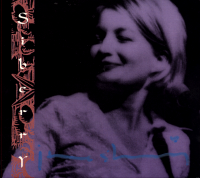 |
22:47: Kajko i Kokosz: Na wczasach by Christa (Zoom)
Huh. This is a Polish comic? I don’t think I’ve ever read a Polish comic before, which is quite strange, really.
Hm… the Danish publication seems to have been sponsored by the Polish state… not a good sign.
Well, they’ve read Asterix, that’s for sure… but then again, haven’t we all?
But this is just rough. I know this is meant for children, but even so — the pacing is just weak, the gags are barely there and there’s really not much characterisation to speak of.
I gave up after about 20 pages.
| Jane Siberry: Lips (Music for Saying It) | 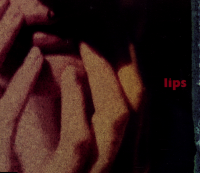 |
23:09: Agent X-9 1/2002 (Egmont)
This sort of thing used to be a thing in Scandinavian comics — 100 page monthly black and white reprints (on cheap paper) of various things, but mostly American and British comic strips. This is the only surviving one, I think, and only in Sweden, so I started a subscription the other year. The only problem is that my appetite for reading the issues is… er… not as high as I imagined. I still like getting them in the mail, though, so I haven’t stopped the subscription, even though I’m at least 15 issues behind on reading them.
But this is the most recent one, so I’m reading it this evening.
The undisputed selling point of this magazine are the Modesty Blaise reprints. There aren’t that many Modesty Blaise storylines, though, so I think they’re at their… fourth? third? round now. In the 80s, they used to ration the Blaise stories so as to not run out as fast, but they’ve given that up now. And I haven’t read this one before — and it’s … pretty good?
It’s a monthly 100 page magazine, so they have room to run some oddball stuff, which is nice. So here’s the only X-9 comic book plot.
And then the other major mainstay, Rip Kirby (here by Alex Raymond), but I’m getting pretty fed up with those bits. I usually read this book in bed before falling asleep, and… it works well for that? Perhaps a bit too well; I get bored before I get sleepy, if you know what I mean.
Which might explain the backlog I’ve got.
| Jane Siberry: Love Is Everything (1) |  |
00:34: Bruno Brazil tome 4 by William Vance & Greg (Zoom)
In the ninth album, Greg killed off most of Brazil’s commando group (which was quite shocking, I seem to remember from when I read that album as a teenager). The introduction here explains that Greg started writing a new album featuring the two characters that were still functional, but then refused to continue, so the Bruno Brazil series dissipated, and they published two make-up albums stitching together the short stories.
So that’s what in this book.
Well… these shorter stories are OK? But reading 90 pages of these at a stretch isn’t ideal.
But Vance’s artwork’s pretty good, at least.
01:37: The End
Look! I made some head-way — the comics are just covering a bit of the view now.
Hm… hey! I read comics for twelve hours straight today. Wow. It was a very mixed batch, with some great stuff and some … er … awful stuff. That’s OK.
